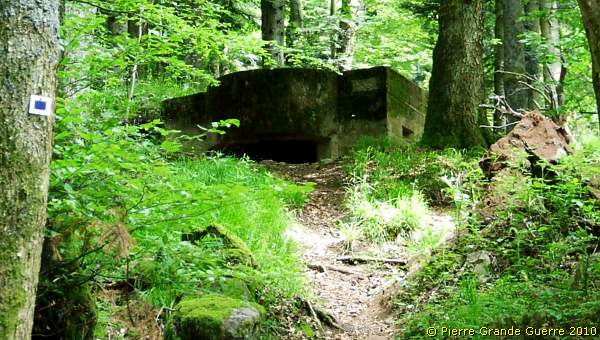AISNE - Chemin des Dames
Year of visit: 2005
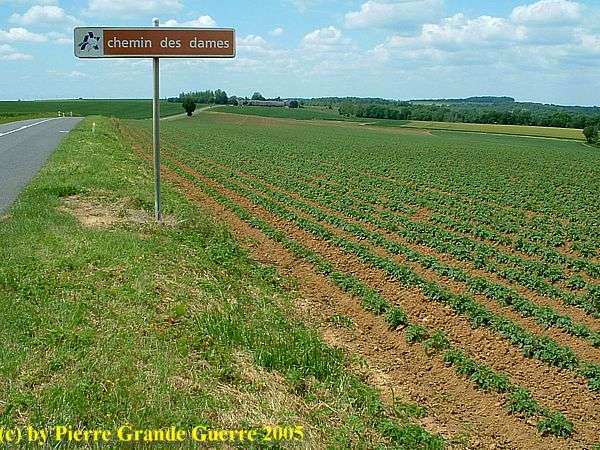
We follow the D 18CD, on the Ridge of the Chemin des Dames, overseeing the valley of the Aisne river. The Germans had fortified this natural fortress on the ridge after the First Battle of the Marne. It is also the infamous battlefield of the bloody Nivelle Offensive of 1917.
Starting from the area of the Fort de Malmaison we follow the road from west to east. We will visit La Royère, the Cerny-en-Laonnois Franco-German war cemetery, the
Braye-en-Laonnois
Chasseurs Alpins Monument, the Caverne du Dragon,
Vauclair Abby, the
Plateau de Californie
, and Craonnelle
. We will finish at the Cholera Farm memorial north of Berry-au Bac. In between you will find frames explaining the historical events of these sites.
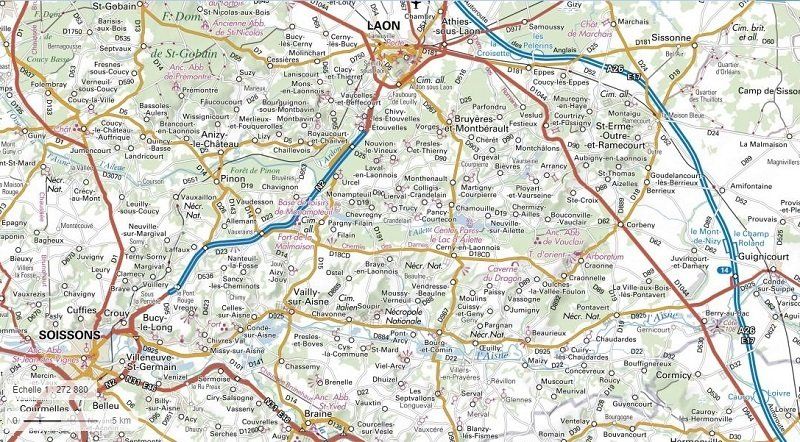
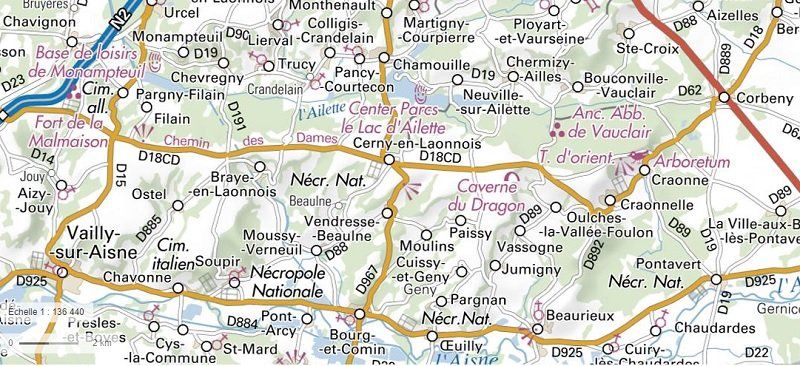

The valley of the Aisne river, from which the French troops had to attack to reach here the German lines on the northern bank.

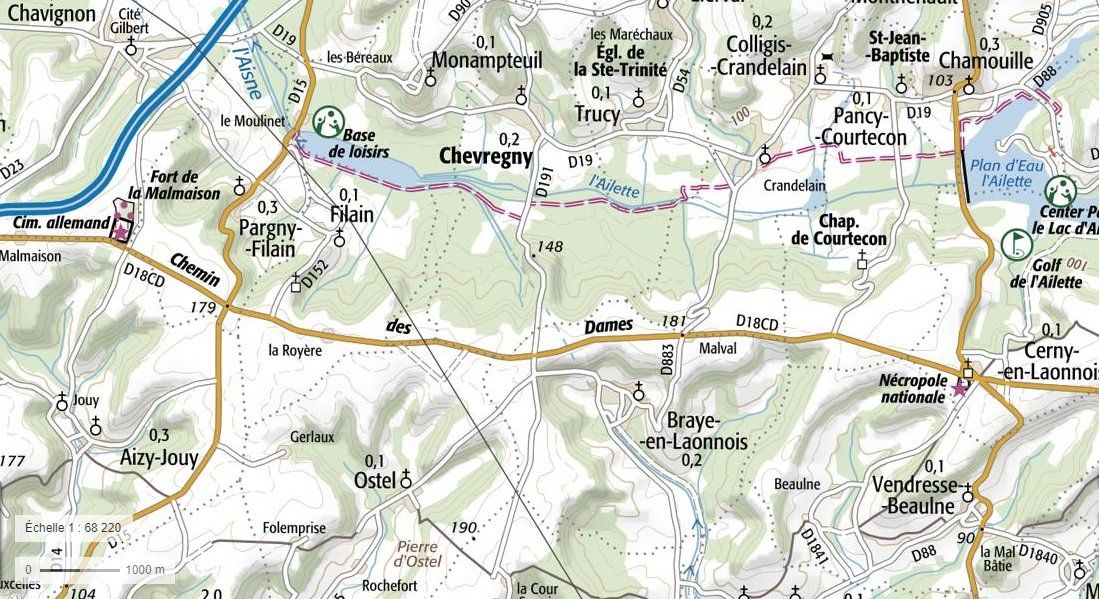
Near Fort de Malmaison we start with the memorial for the Colonial Infantry Regiment of Marocco
or the R.I.C.M. , ...
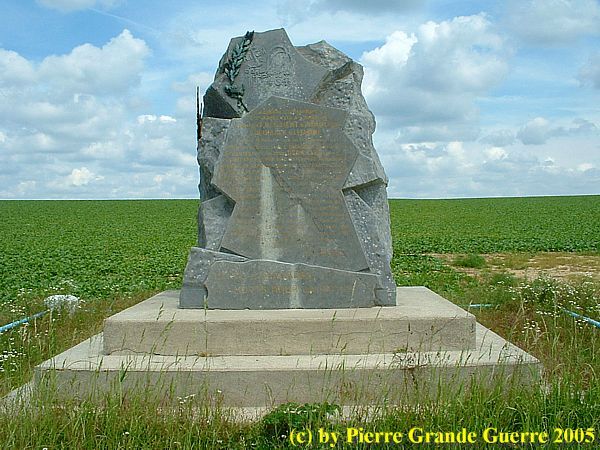
... le Régiment d'Infanterie Coloniale du Maroc.

During the Nivelles-offensive of 16 April 1917 the French deployed many of their Colonial Troops, like the Régiment d'Infanterie Coloniale du Maroc.
After many combats starting on 16 April, but also in May and June, finally the French troops of the 11e, 14e et 21e Corps d'Armée
captured on 25 October 1917 with support of tanks the Fort de Malmaison. In contrary to the tank attack of 16 April, this time the tanks contributed successfully to the French victory. On 25 October the Germans counted 8,000 soldiers killed, 30,000 wounded and 11,500 prisoners.
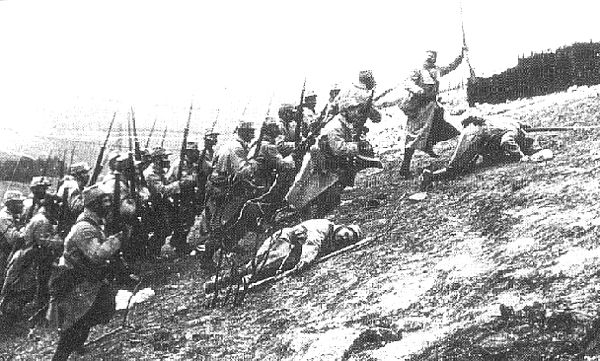
This small wood is hiding the ruins of Fort de Malmaison , occupied by the Germans since October 1914.
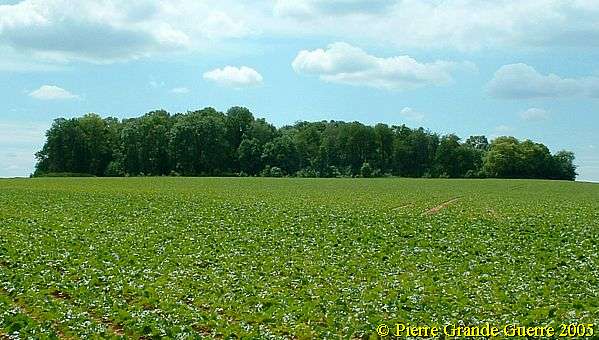
The R.I.C.M. and other colonial troops had to attack the well defended Fort de Malmaison.

The overgrown ruins of Fort de Malmaison, now unaccessible to the public.
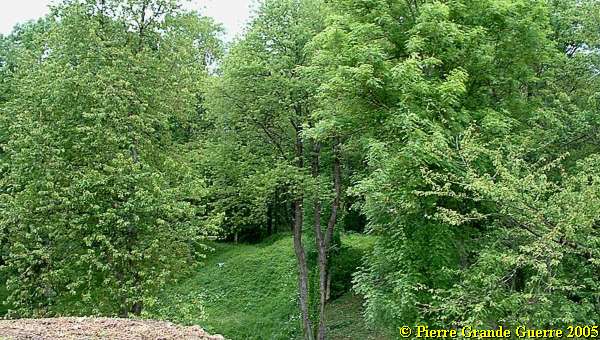
This monument in front of the overgrown Fort de Malmaison commemorates the succesful attack of the Zouaves and Tunesian Regiments on 23 October 1917.
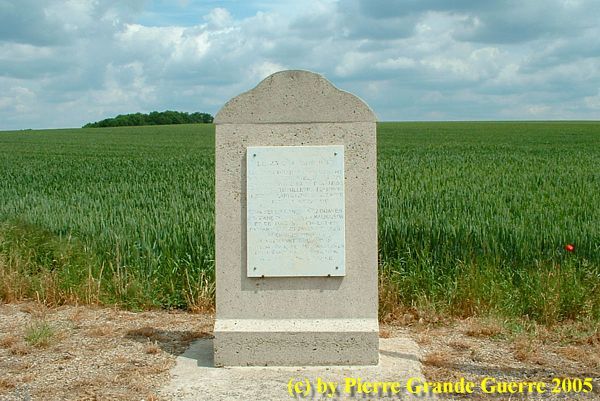
"Le 23 octobre 1917 la 38ème Division comprenant le 4ème Régiment Zouaves, le R.I.C.M., le 4ème Régiment mixte Zouaves-Tirailleurs, le 8ème Régiment Tirailleurs Tunisiens, le 32ème Régiment d'Artillerie de campagne, part à l'attaque.
D'un seul élan, le 4ème Zouaves s'empare du Fort de la Malmaison et de tous ses objectifs, faisant les 23-24-25 octobre 600 prisonniers, capturant 17 canons et de nombreuses mitrailleuses, obtenant sa 6ème citation à l'Ordre de l'Armée."
Translation : see below the next image.
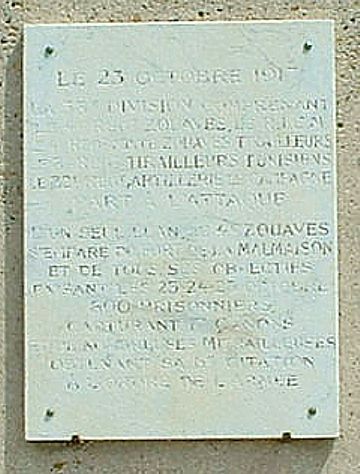
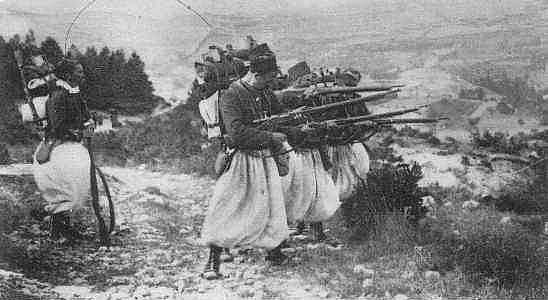
But before the French Army Corps would reach this victory on 25 October , the battles on the Chemin des Dames started with a bloody failure in April 1917.
The
Nivelle Offensive - 16 - 23 April 1917
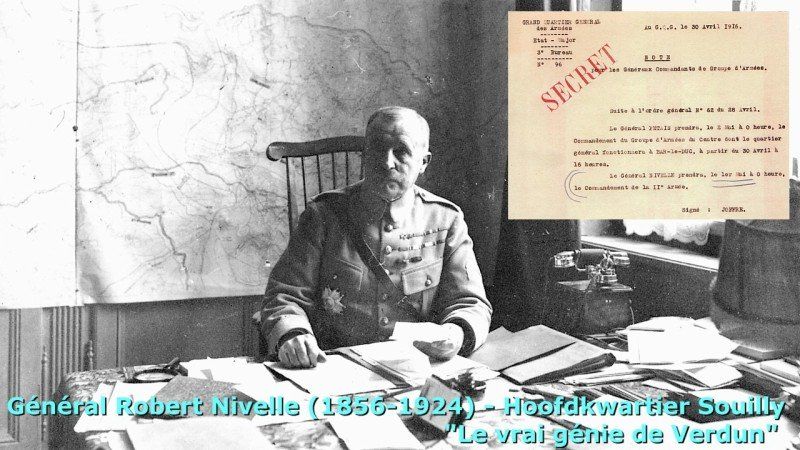
From January 1917 the French army licked its wounds from the exhausting battles in 1916 at Verdun and on the Somme. The Battle of Verdun in particular was hardly a success, and the commander-in-chief, Général Joffre, lost his job.
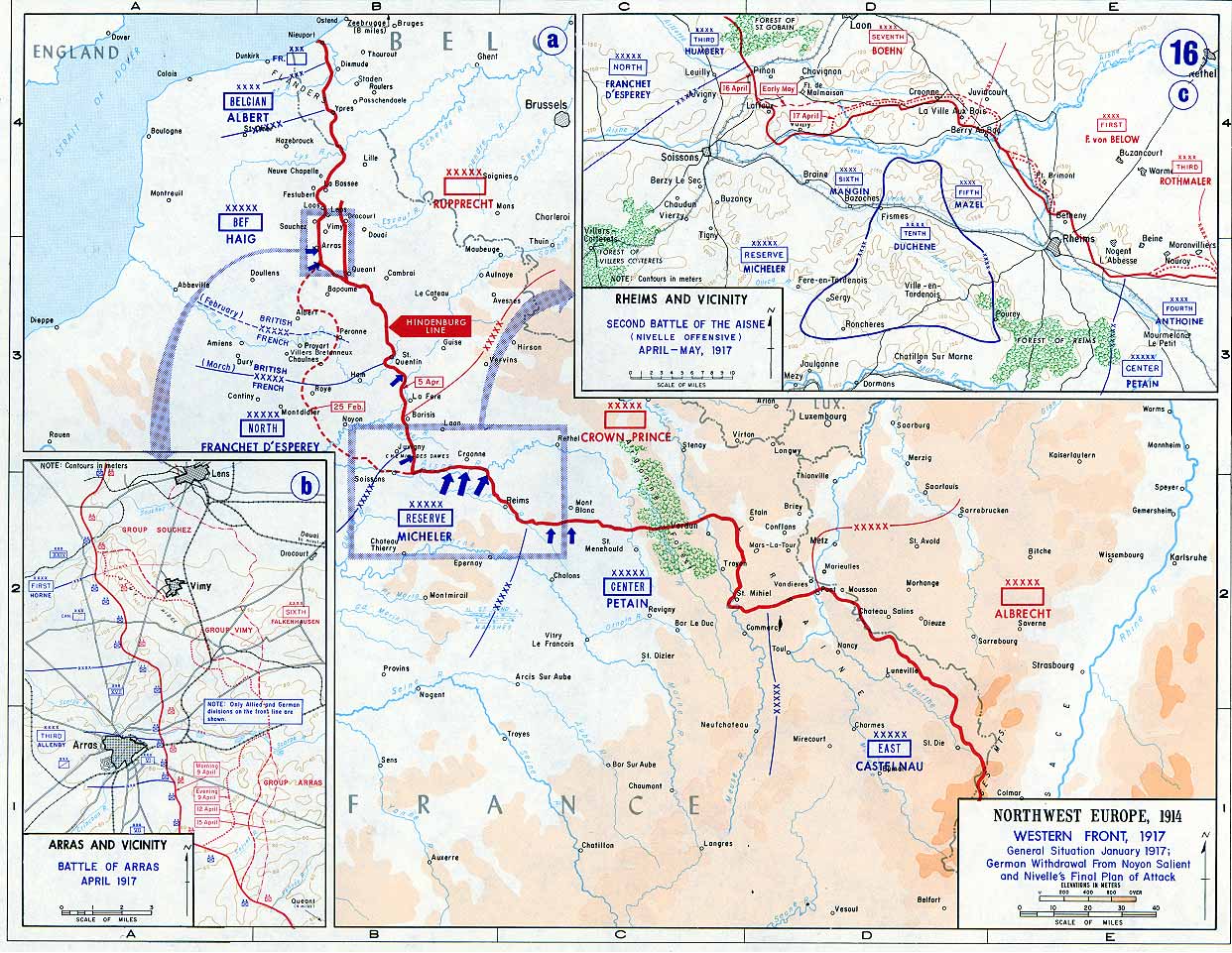
On 16 April 1917, the new commander-in-chief, Général Nivelle, launched a new offensive on the Aisne front, the Nivelle Offensive also known as the Second Battle of the Aisne. The offensive goals were the German positions between Laon and Rethel, but the offensive was in particular directed at the German positions along the Chemin des Dames. On this page I will focus on the sector of the Chemin des Dames.
Nivelle was at the head of operations. On the battlefield fought the Reserve Army Group under the command of Général Micheler, which was composed of the Fifth Army under Général Mazel, of the Sixth Army under Général Mangin and of the Xth Army under Général Duchêne.

Mangin's task was to attack the sector on the line Laffaux – Fort de Malmaison - Hurtebise Farm with 17 divisions of the XXXVIIe, VIe and the XXe Corps d'Armée, and the Corps Coloniale.
Many regiments of the colonial troops, Senegalese soldiers, Moroccans, and Algerien Zouave riflemen, were deployed as "shock troops".
African troops had to attack the most strategic sector of the plateau, the Hurtebise isthmus and the Dragon's Cave. Of the 15,000 Africans attacking the German lines, 6,000 will die on the first day of the offensive, on 16 April!
The Fourth Army of General Anthoine, also in reserve, had 5 divisions of infantry and the 2nd Colonial Army Corps under the orders of General Blondlat.
In total the attack French force existed of 850,000 men, 200 tanks, 2,700 75 mm artillery guns and 2,300 heavy mortars, including 790 modern cannons.
The German Defenders of the Chemin des Dames

The 22 divisions of 4 Armeegruppe of the German 7. Armeekorps under Generaloberst Max von Boehn defended the German positions on the Chemin de Dames: Gruppe Crepy, XXIII. Reserve-Korps under General der Infanterie Hugo von Kathen, between St. Gobain and Vauxaillon; Gruppe Vailly, XI. Armee-Korps under Generalleutnant Viktor Kühne, between Laffaux and Malmaison; Gruppe Liesse, or Generalkommando 54 under General der Infanterie Eduard von Liebert between Courtecon und Ailles; Gruppe Sissonne, XV. Reserve-Korps under General der Artillerie Max von Höhn, from 19 April Generalkommando 65 under Generalleutnant Eberhard von Schmettow between Hurtebise and Craonne.
This force counted about 340,000 men.
The front sector in the east, between Berry-au Bac and Reims was defended by 19 divisions of the 1. Armeekorps under General der Infanterie Fritz von Below.
This force counted also about 340,000 men. The front sector of the
1. Armeekorps lies outside the topographic range of this photo impression.
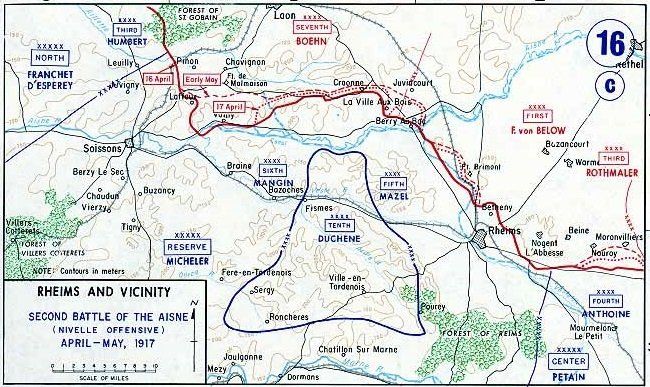
In seven days, Nivelles gained only 500 m. of terrain and wasted, almost carelessly and unnecessarily , the blood of 187,000 French soldiers, including many colonial soldiers. On 23 April, after only 7 days of the offensive, all further operations were immediately forbidden by Président Poincaré personally. Poincaré forced Nivelle to resign at once. After 7 days of battle there were 187,000 French casualties and 167,000 German casualties.
Mutinies
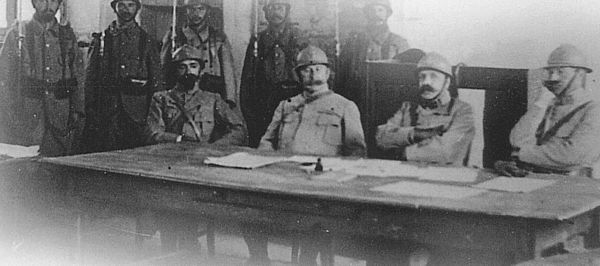
During the battle, the first uprisings began and small mutinies initially broke out, which would soon expand on a larger scale. Soldiers still refused to leave the trench as meaningless cannon feed or to follow other orders. In addition, among the front soldiers there was also the paralyzing influence of socialism. That socialism blown over from revolutionary Russia was regarded at the top of the army as dangerous for the state and undermining the right combat morality.
On 23 April even President Poincaré has had enough of Nivelle's needless slaughter with no visible result and he fired him immediately. On 25 March Poincaré also dismissed General Lyautey from his position as Minister of War.

It was the "Hero of Verdun", General Pétain, who succeeded Nivelles as supreme commander. To restore order in the ranks, Pétain had 27 soldiers of the 30,000 mutineers executed by a firing squad as an example to others. As a result of these mutinies, the French Army could only hold a defensive position in the trenches until the arrival of the Americans in 1918, but it could no longer launch attacks with those "unreliable", rebellious soldiers.
After the battle the hostilities were not over. In the end of May, the end of June, and the end of July, the artillery bombardments and combats will resume in the Hurtebise front sector of the Chemin des Dames. Later on this page I will explain these 1917 summer events around the Caverne du Dagon.
The Dutch-born Joost van
Vollenhoven
, ...
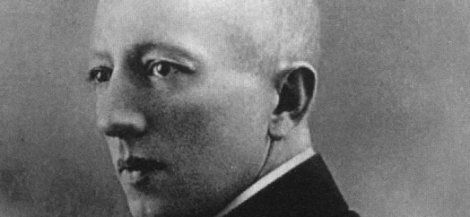
... an heroic and higly
decorated officer of the R.I.C.M., made critical and unwelcome remarks
about the bloodshed during the recruiting and employment
of African Colonial Troops during the offensive.
( Dutch
readers! Read also
my article: Kapitein
Joost van Vollenhoven
)
We leave la Royère and Fort de Malmaison to continue westward in the direction of to Cerny-en-Laonnois.
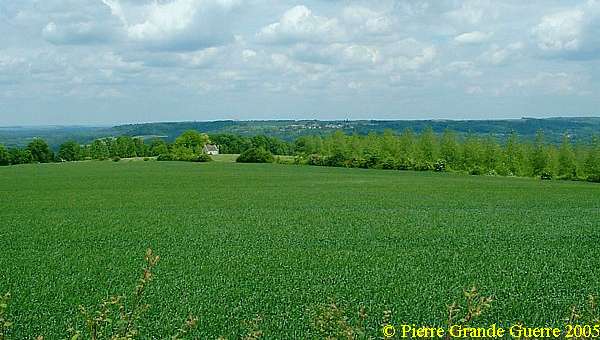
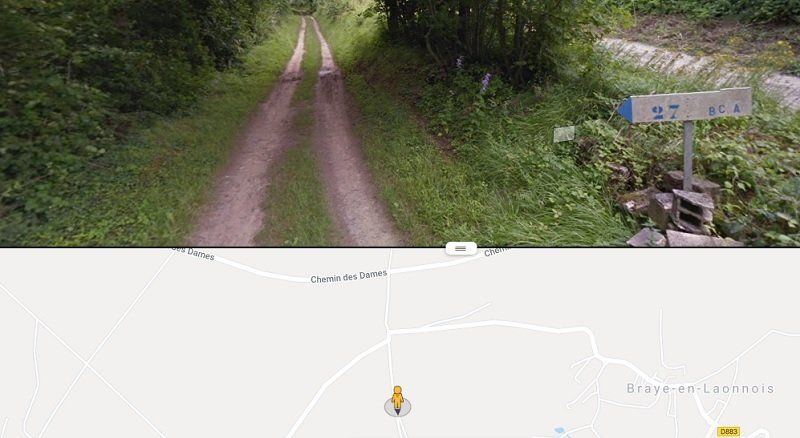
Near and before passing Braye-en-Laonnois we turn right on the D 883 and from there we take a small, sandy side road, to reach a high point, ...
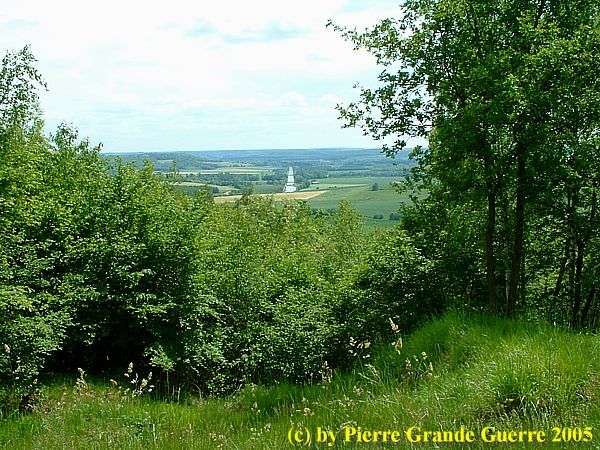
... overlooking the Aisne valley in the direction of the Oise-Aisne Channel.
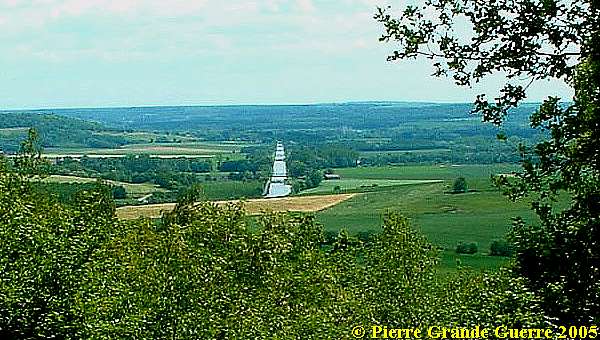
From this valley the 27e Bataillon Chasseurs Alpins, special mountain troops, attacked succesfully this steep hill during the Nivelle Offensive.

This monument commemorates this event and all soldiers of the 27th Battalion and its Reserve Battalion, the 67th, killed in both World Wars.
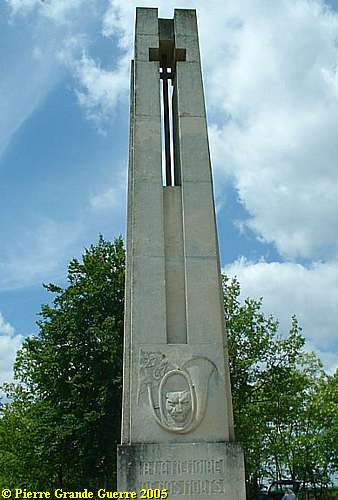
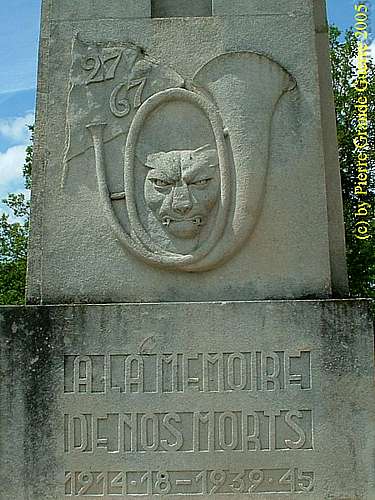
We return to the Chemin des Dames to continue to Cerny-en-Laonnois, a centrepoint of the Nivelles-offensive.
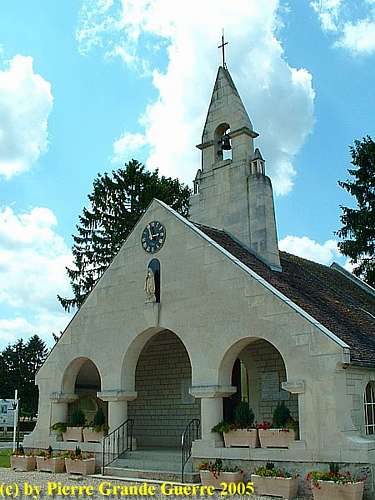
Here we find the Nécropole Nationale de Cerny-en-Laonnois , divided in two large plots; a French and a German one, lying next to each other.
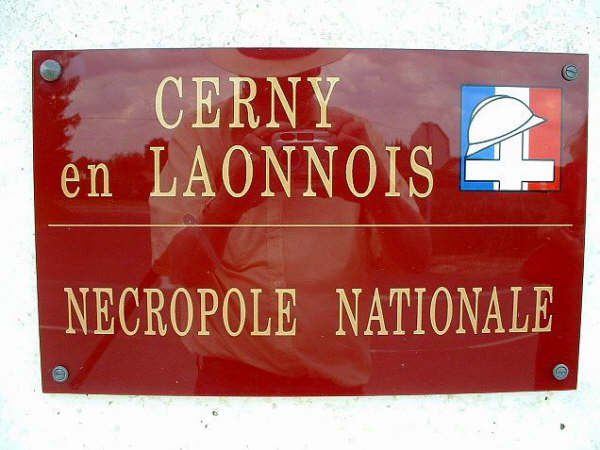
We will first visit the French plot.
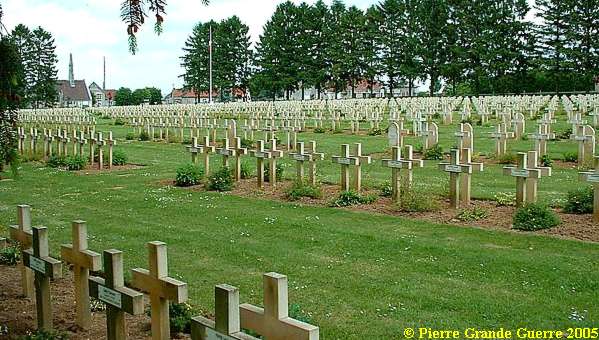
The Nécropole Nationale de Cerny-en-Laonnois
is located on the D18 left, when entering the village. It was created between 1919 and 1925 for corpses exhumed from the cemeteries of the communes of Beaulne, Paissy, Braye-en-Laonnois, and Moulins. Here are buried 5,150 French and 4 Russian soldiers, killed during the battles of Troyon, Vauclerc, Vendresse.
Source:
fr.geneawiki.com
This soldier has been a member of 51e Bataillon Tirailleurs Sénégalais (from Senegal).
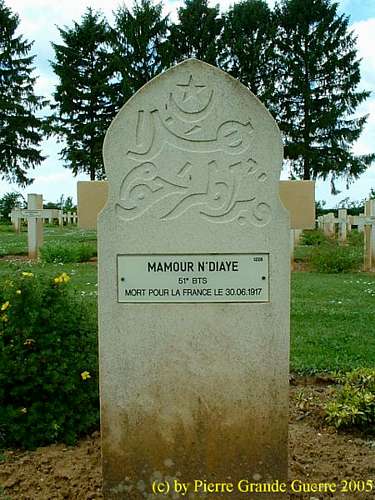
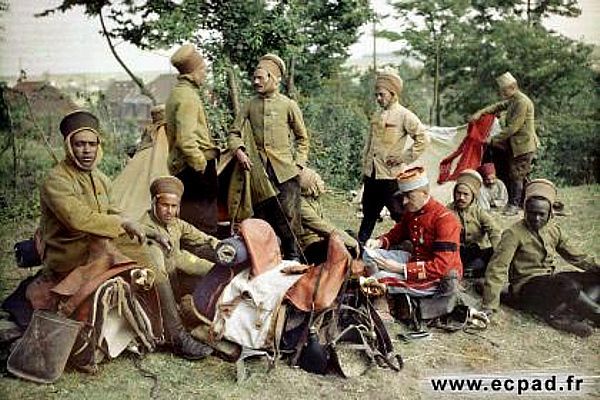
Private Moinvoisin died already somewhere here during the First Battle of the Marne in 1914.
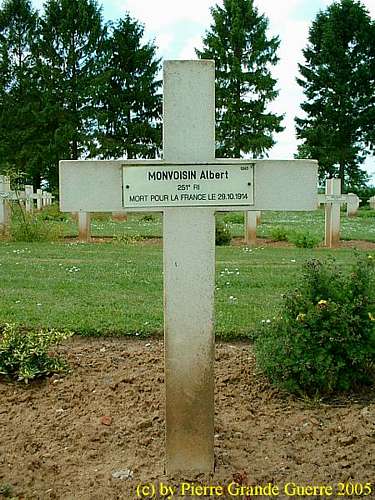
A view over the battlefield from the edge of the German war cemetery.
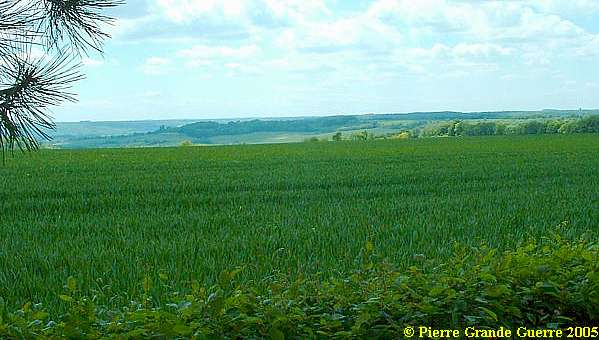
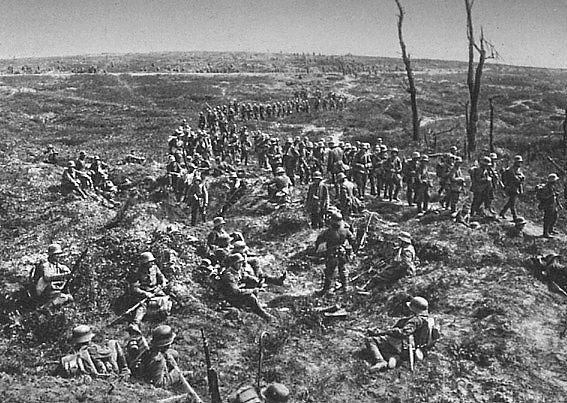
We step over to the German cemetery.
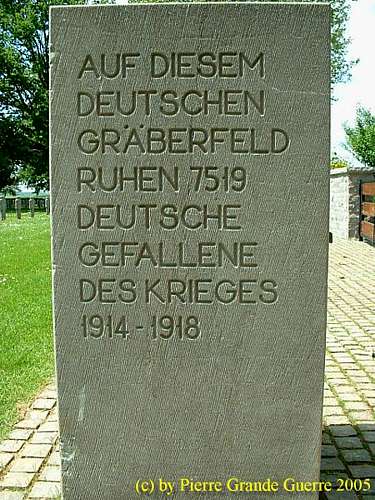
In the years 1924/1925 the German cemetery was significantly extended with more graves from the combat area at the Chemin des Dames. Most of the victims lost their lives in the defensive battles from the fall of 1914 to the spring of 1915, the French offensive in April / May 1917, the German attack in May 1918, and the September / October 1918 withdrawal battles. These soldiers came from garrisons in Westphalia, Brandenburg, Saxony, Württemberg, Schleswig-Holstein and West Prussia. Particularly high losses suffered the Rhineland, Lower Saxony and Mecklenburg regiments.
Of the 7,546 dead, 3,553 rest in individual graves. Of these, 66 remain unknown. There are 3,993 victims buried in the communal grave. Only from 964 is the name known.
Source: Volksbund Deutsche Kriegsgräberfürsorge
We find graves of soldiers fallen during all four years of the war.
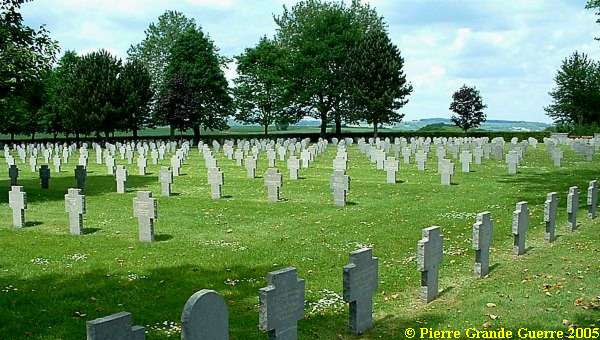
Just a reminder: 167,000 German casualties during only 7 days in April 1917!
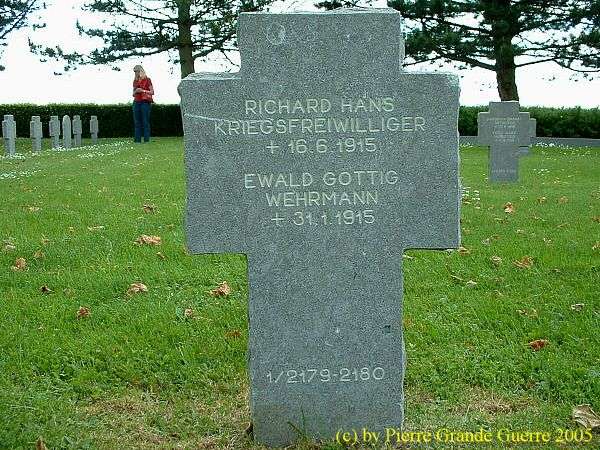
The Hebrew words on the grave of the Jewish Moritz Mannheimer mean ...
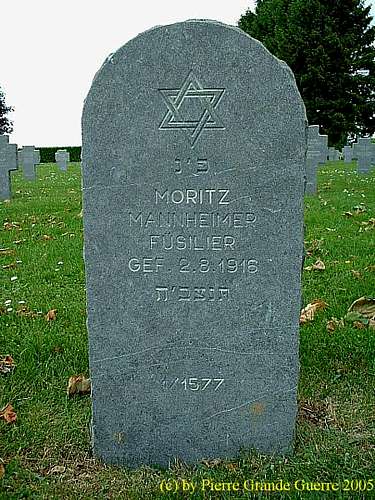
The Chapel of Cerny-en-Laonnois commemorates the soldiers without a known grave. In spring: please, leave the door open for the new life of the young birds, living in their nest in the Chapel.

We continue eastward in the direction of the Caverne du Dragon.
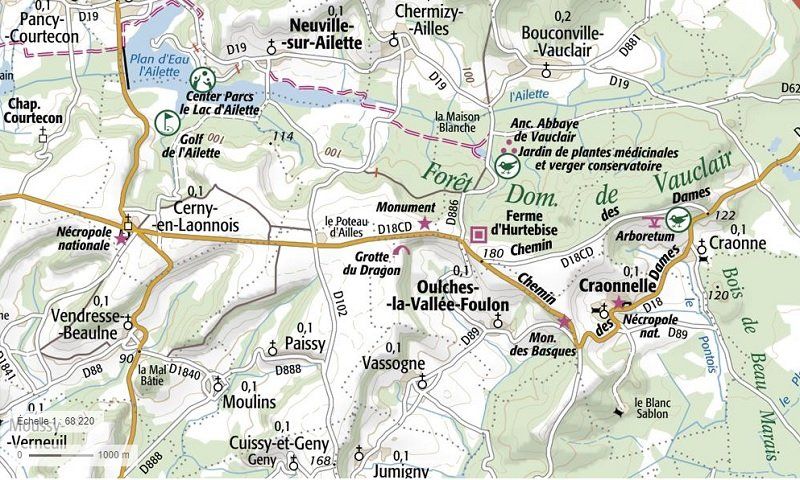
Some kilometers before the Dragon's Cave: a monument, erected by a family, for a nearby fallen soldier, Second Lieutenant Louis Astoul of the 70e Bataillon Sénégalaise, who fell on or near this spot on 16 April 1917.

Now we enter the area of the Hurtebise front sector and in particular the Caverne du Dragon , or the Dragon's Cave, wich the Germans called the Drachenhöhle.
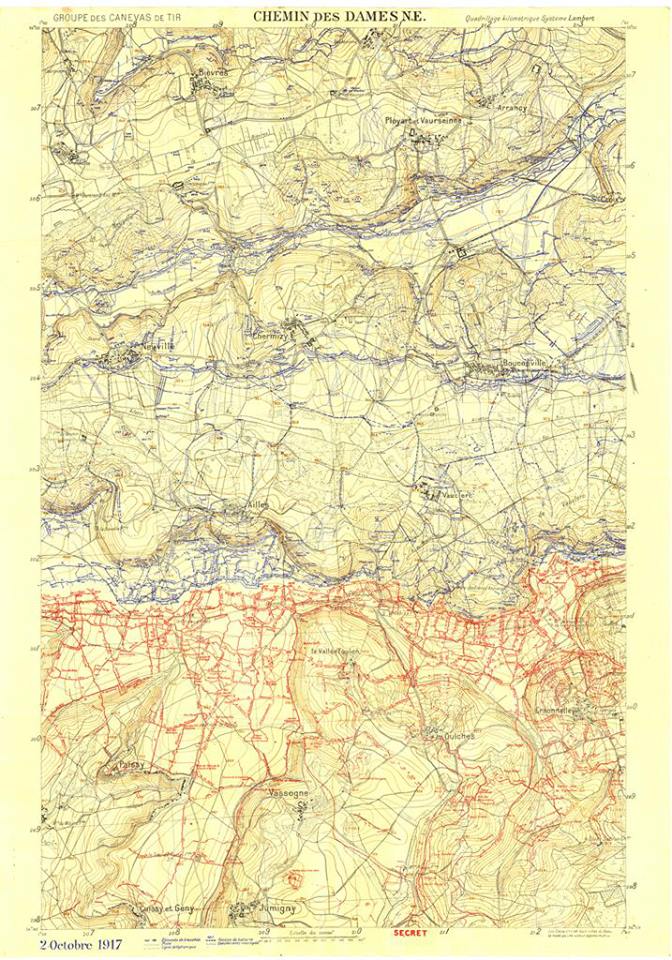
This panorama from the entrance of the Dragon's Cave gives an impression of the German view point from the plateau of Hurtebise.

Again zoomed in, to the left, ...
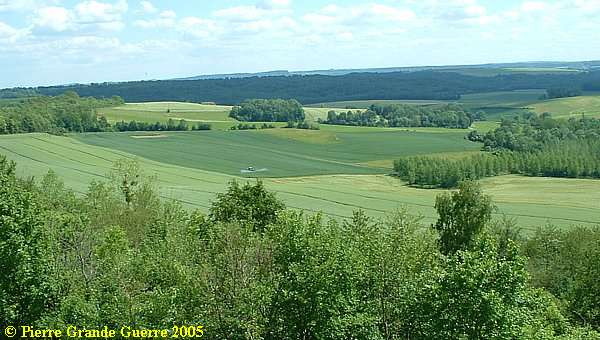
... and to the right.
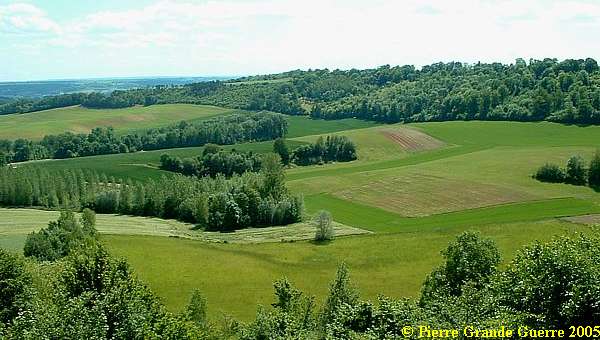
Near the entrance of the Dragon's Cave stand along the road some memorials to commemorate the heroic acts of the 57e Brigade Chasseurs à Pied, ....
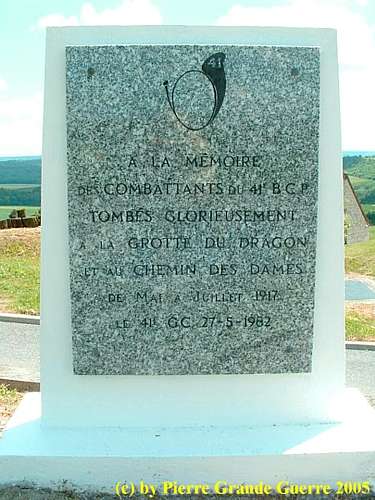
... the leading 164e Division d'Infanterie, involved in all 1917 combats ...

... and the 4e Régiment des Zouaves, reminding us of some fallen soldiers of the First Battle of the Marne .
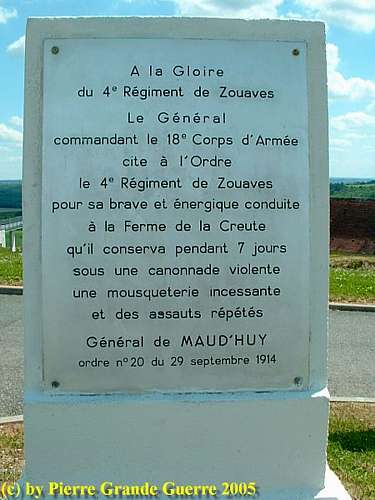
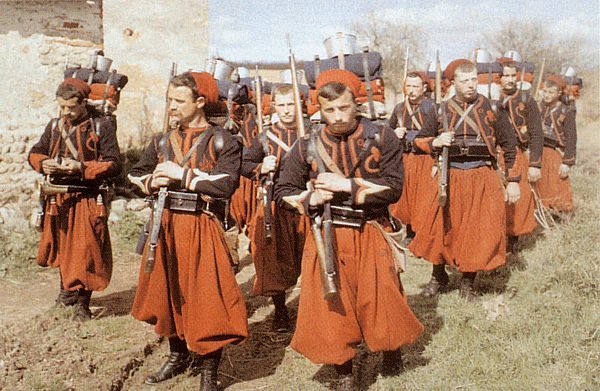
Some relics of a trench near the entrance of the Caverne du Dragon.
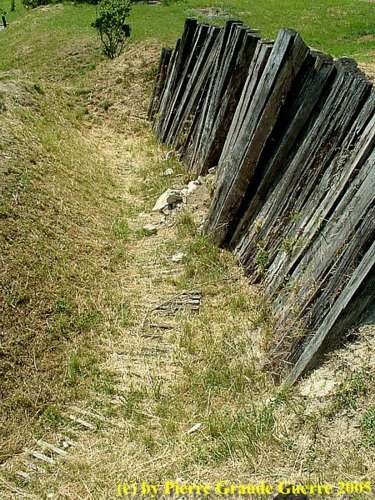

The modern and ugly entrance of the Musée du Caverne du Dragon , which gives a guided access to the cave.
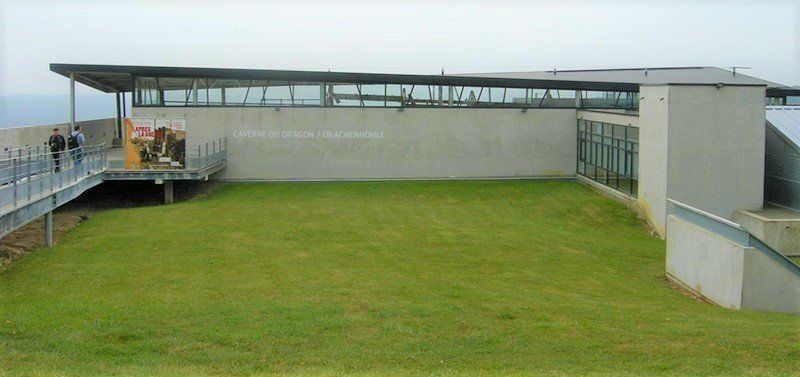
With an elevator we enter the quarry.
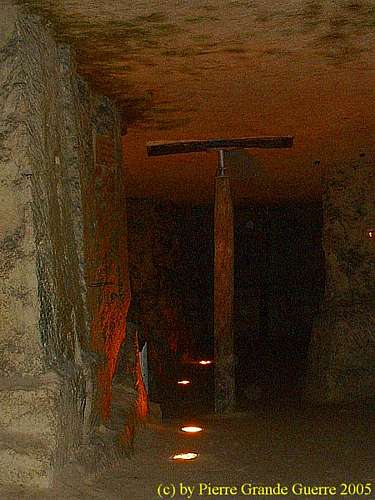
Downstairs we pass a mortar.
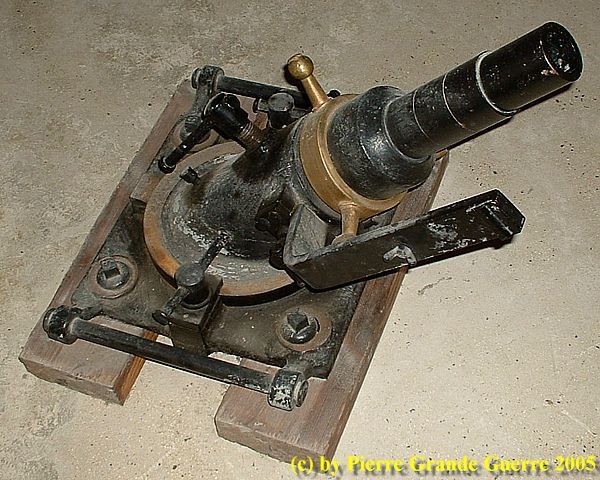
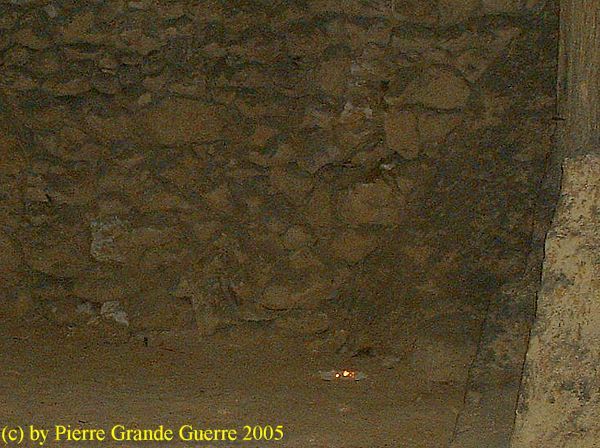
Before we continue our exploration of the Caverne du Dragon, first I will sketch you below some background information.
The Caverne du Dragon - Drachenhöhle
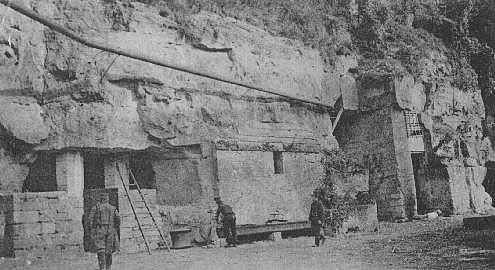
The cave is originally an underground quarry, with an area of 3 hectares located at 14 meters of depth, dug in the Middle Ages in the limestone of the plateau of the Chemin des Dames. Its stones were used in particular for the construction of the abbey of Vauclair, which we will visit later on this page.
These quarries, or "creutes", found in the Somme as in the Aisne, were used as underground barracks, shelters, fire stations, to accommodate staffs or, as it is the case here, as an advanced defensive post.
The Dragon's Cave is located near the height of Hurtebise, west of Hurtebise Farm, where the plateau is the narrowest. In addition, as we have seen above, its position on the edge offers a wide panorama of the Aisne Valley.
16 April 1917
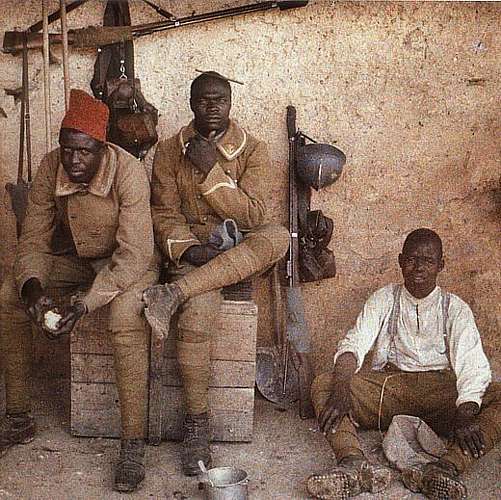
On 16 April 1917, during the onslaught of the Nivelle Offensive, Germans emerging from the Dragon's Cave surprised the Senegalese soldiers, who had set out to capture the isthmus of Hurtebise. The Senegalese were disoriented and in panic: the German counter-attack stopped their progress. The existence of numerous "creutes" connected to the rear by tunnels, hiding German troops, was one of the explanations of the failure of the Nivelle Offensive.
The 1919 "Historique" of the 152e R.I. also blames the failure to the tanks, which apparently were unable to progress enough over the steep and muddy terrain. After several attacks in April and May, the French, held some trenches at the level of the isthmus of the Hurtebise. The Dragon's Cave was still occupied by the Germans.
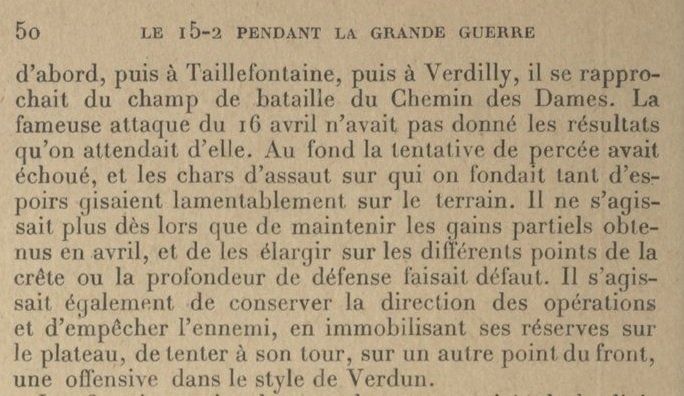
25 June 1917 - Attack at the Caverne du Dragon
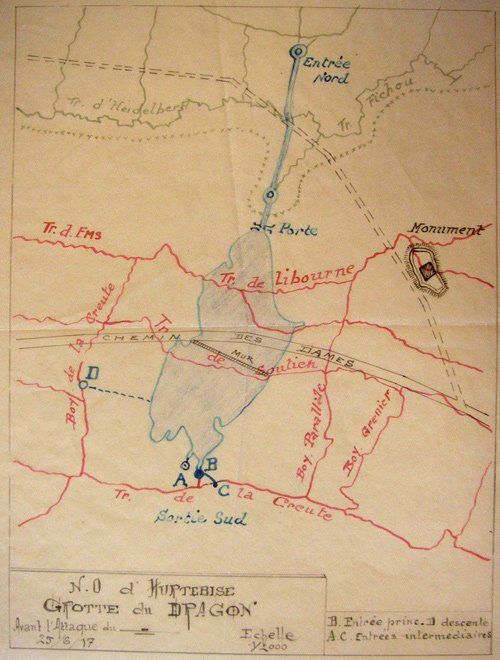
On 25 June the 164th Infantry Division was charged with conducting another attack to control the entire Hurtebise isthmus and, if circumstances permit, to occupy the northern exit of the Dragon's Cave.
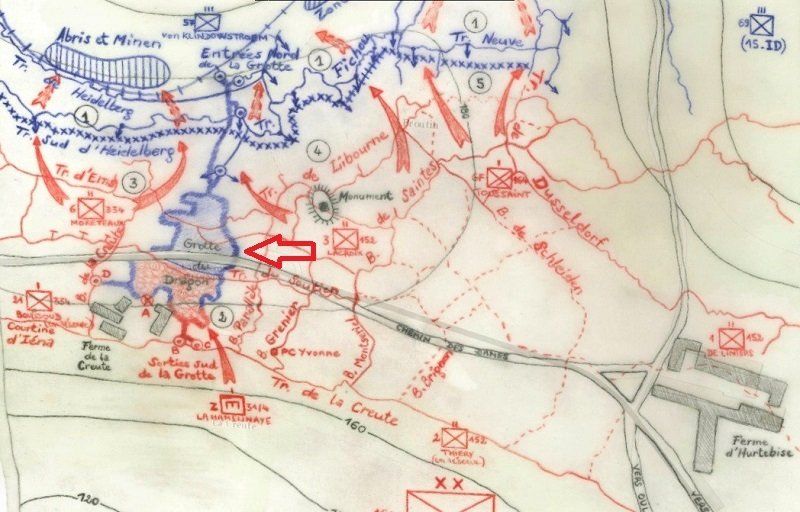
After an artillery bombardement of 5 hours and In preparation for this attack, the French sent poison gas in the southern entrances of the cave to trap the Germans.
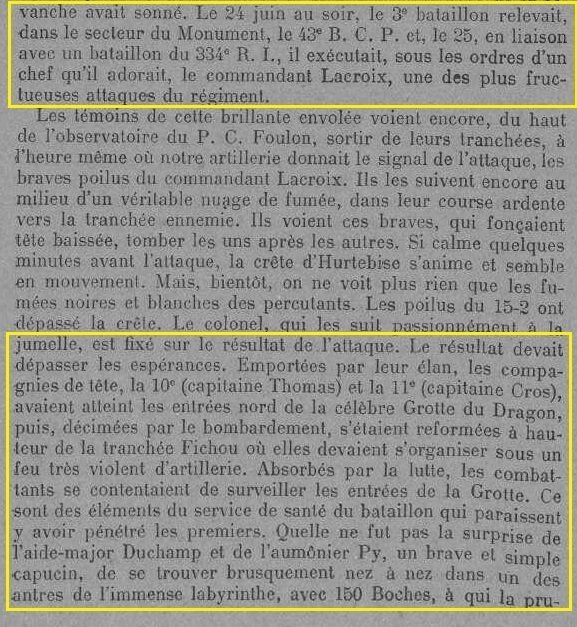
The assault was conducted under cover of a smoke curtain at 18.00 hrs. by the III Battalion under Major Lacroix of the in France still famous 152e Régiment d'Infanterie, the Red Devils Regiment, and the Moréteaux Battalion of the 334e R.I.. The Germans answered this attack with artillery fire.
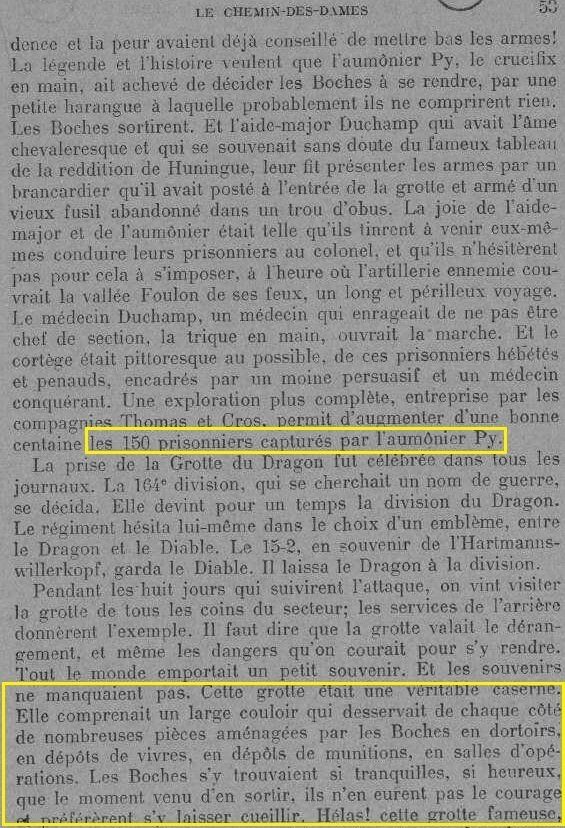
Eventual resistance nests in the cave and the nearby "creutes" were cleared with "Schilt" flame throwers.
The exploration of the trenches revealed the presence of German troops who, after negotiation, agreed to surrender. The number of prisoners counted at the end of the day 340 Germans , including 10 officers . During the combats in the cave Doctor Duchamp and Almoner Py of the 152e R.I. "
took 150 Germans prisoner! " (.....)- "The cave served as genuine barracks".
The capture of the cave was
in France then
celebrated as a great military victory .
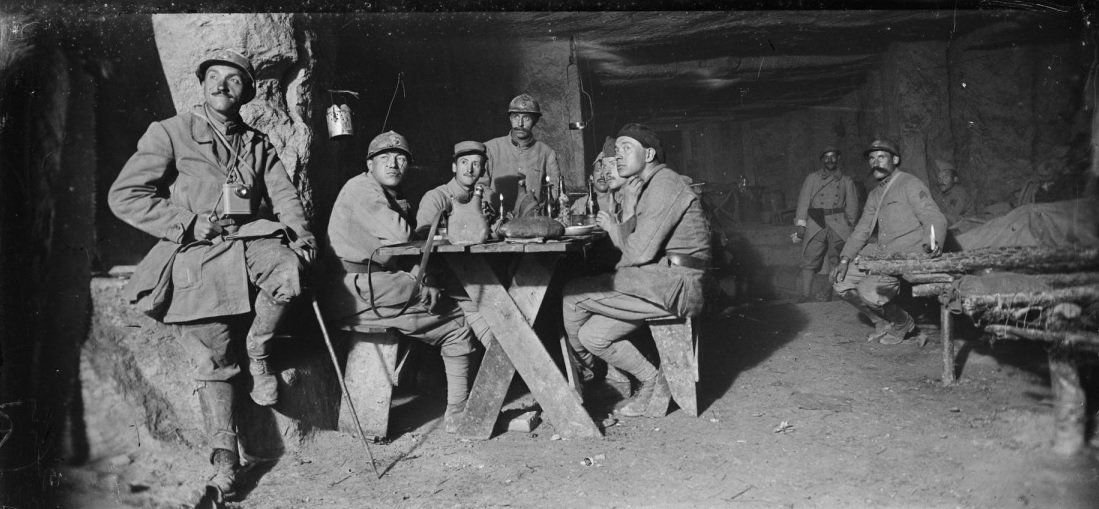
Fragment from the "Historique" of the 152e R.I. , "THE 15-2 DURING THE GREAT WAR" - 1919: ....

"The 15-2 has lost on the Chemin des Dames during the attacks of 22 May, 25 June and 24 July more than 40 officers and almost 1,000 men. On the other hand almost 400 prisoners stayed in its hands, and it had captured numerous machine-guns, provisions and munitions in the Dragon's Cave, five field guns (three of 77 mm and two of 88) and a trench gun. The "poilus" of the 15-2 have all the right to be proud." - ( "THE 15-2 DURING THE GREAT WAR" - 1919)

Cohabitation - 26 July - 2 November 1917
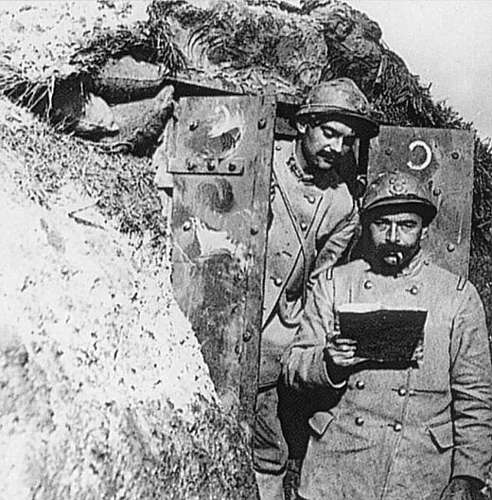
On 26 July 1917, German assault troops managed to regain the northern part of the quarry, which led to a rather peaceful cohabitation with the French in the southern part until 2 November.
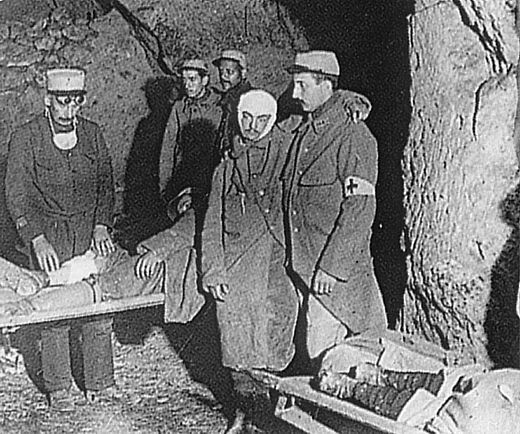
In late October 1917, following the German retreat after the Battle of Fort de Malmaison, the cave had been reorganized and turned into the Command Post of the Hurtebise front sector.
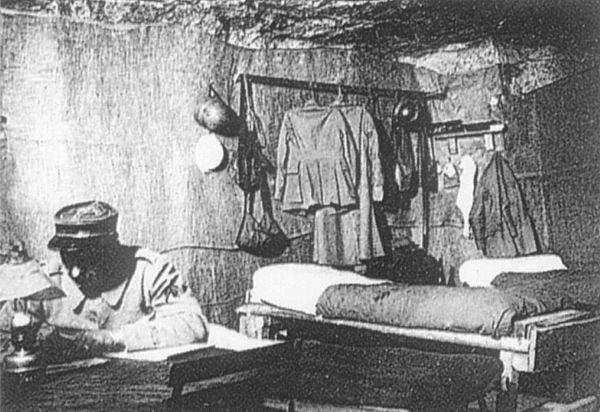
On 27 May 1918, during the German Operation Blücher-Yorck, the French troops were overwhelmed and the defenders of the Dragon's Cave were forced to surrender. The quarry would be recaptured by the French troops, on 12 October 1918, after the retreat of the German troops the day before.
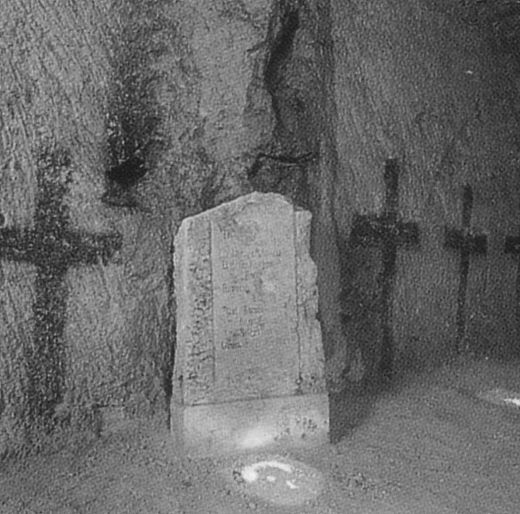
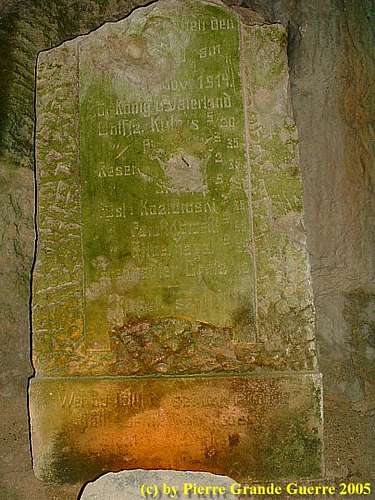
Armed with these historical backgrounds we continue our guided tour in the Caverne du Dragon.
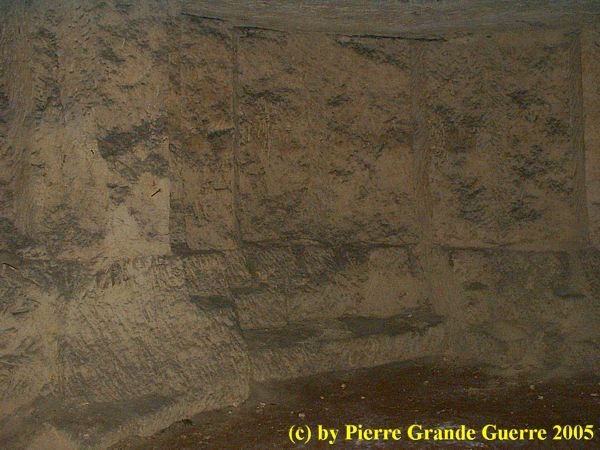
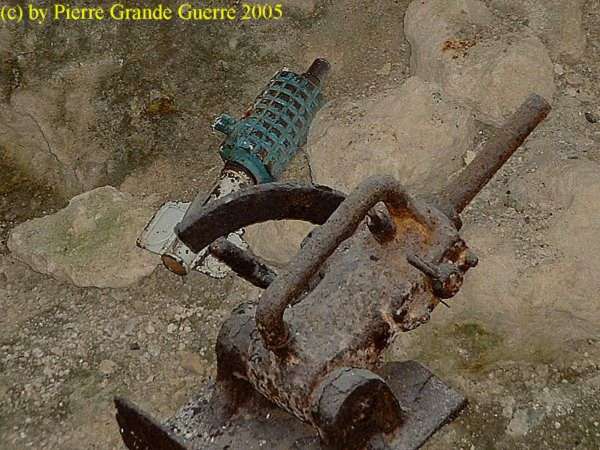
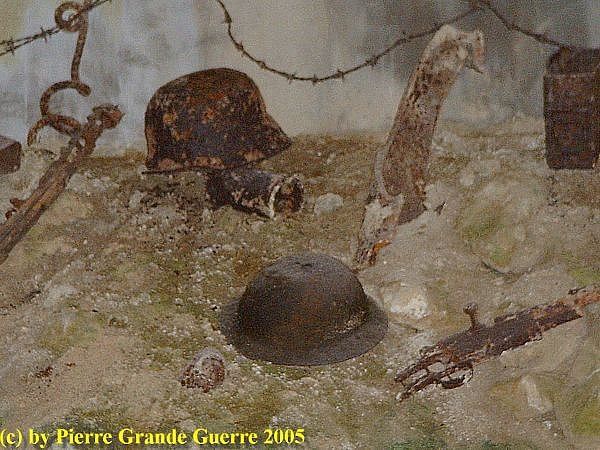
The French sector of the quarry.
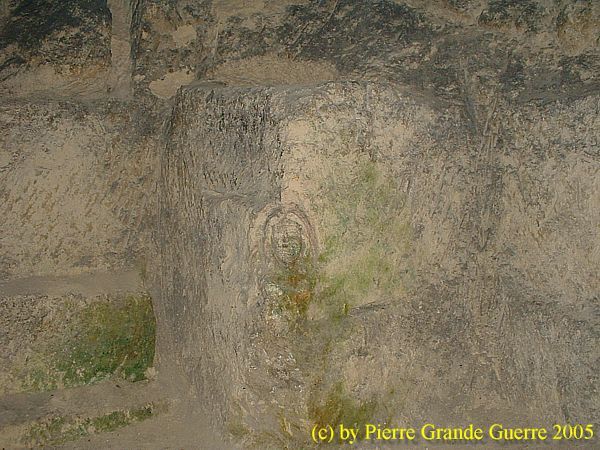
Soldiers carved and graffitied in the walls.
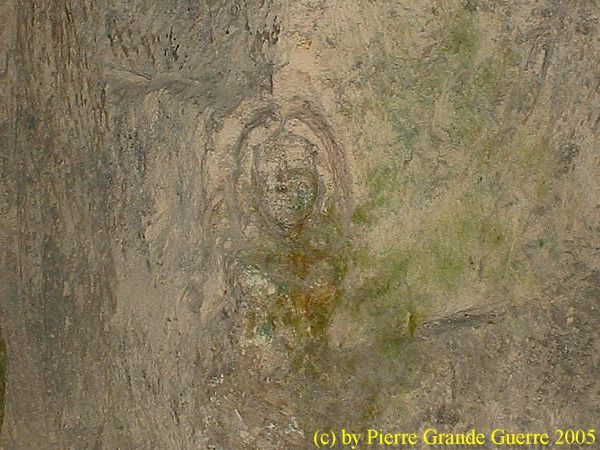
Nowadays the corridors are distastefully lighted.

The front line crossed the quarry and it divided the quarry in a German sector and a French sector. At the end of this tunnel starts No Man's land.
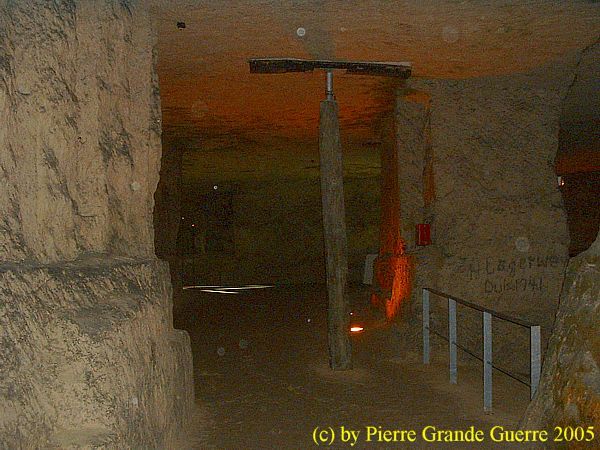
No Man's land in the centre of the quarry, seen from the French side.

We change now to the German sector looking to the French lines, some few meters away.
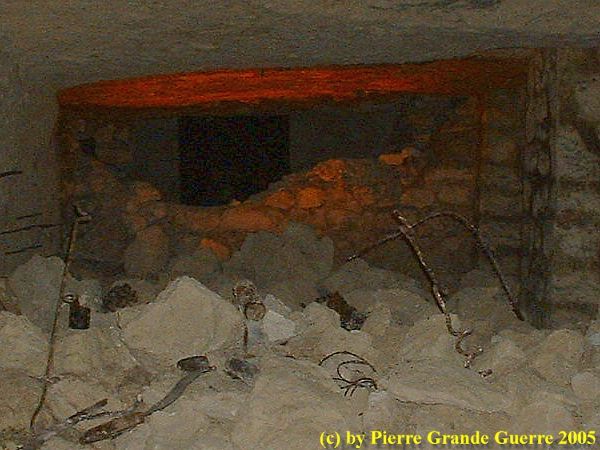
The Germans created since 1915 an underground complex with a command post, dormitories, a dressing station, ammunition stores, and a chapel with some graves.
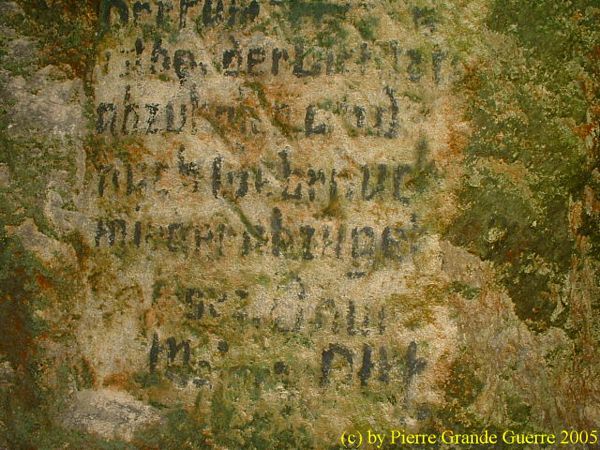
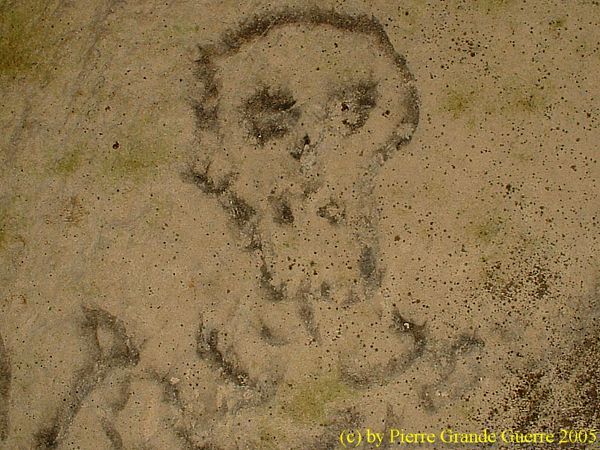
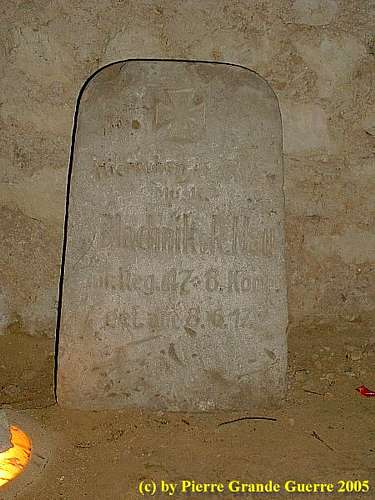
The Germans installed a power station, a telephone line and a source with a pumping system providing fresh water.

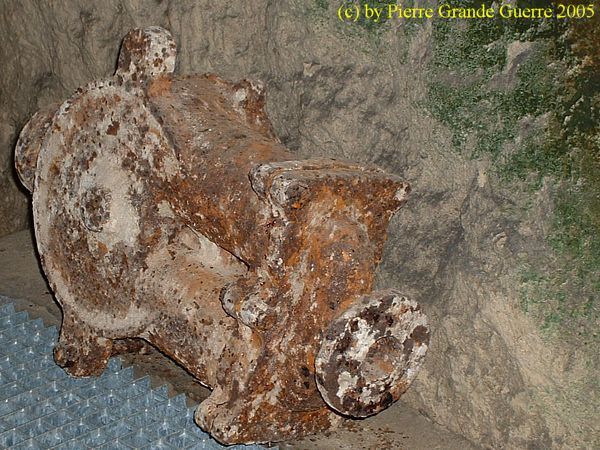
But during the "cohabitation" period the French were always close by.
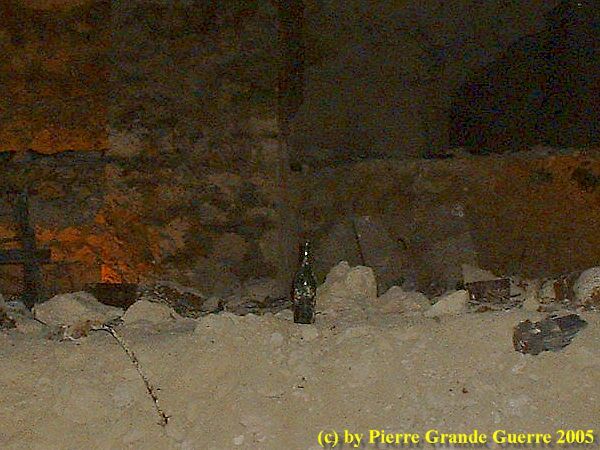
During that period of cohabitation there were hardly fights in the quarry. Both parties were glad to possess a piece of a relatively safe place.
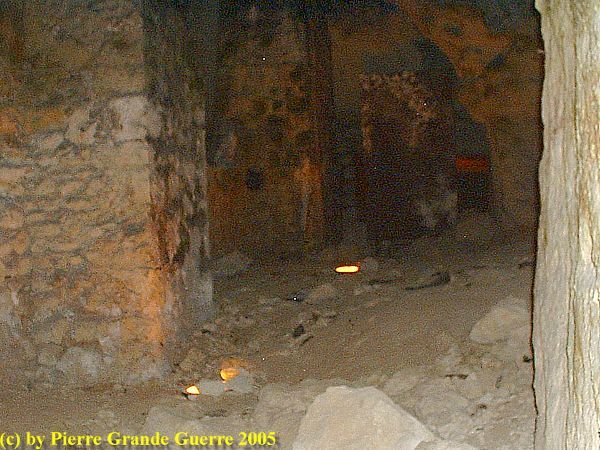
No Man's land from the German side.
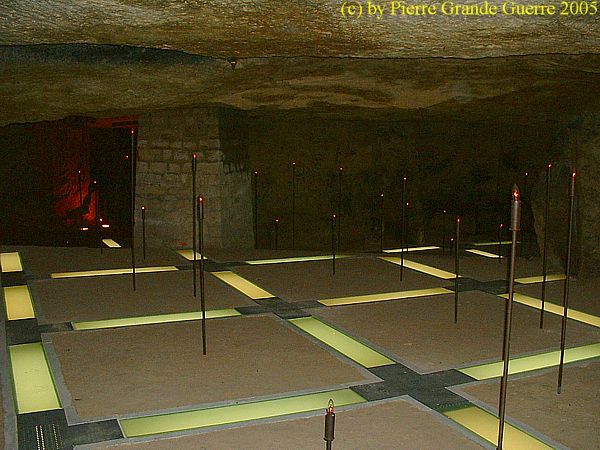
We return to the French sector and pass the point of an impact of an artillery grenade, ...
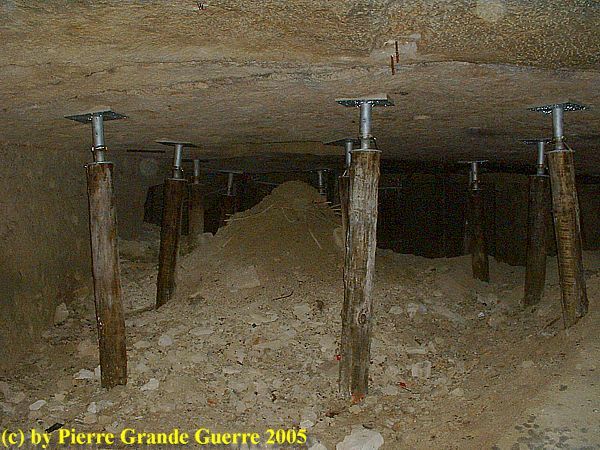
... which killed 12 French soldiers, who are still buried in the heap of debris.
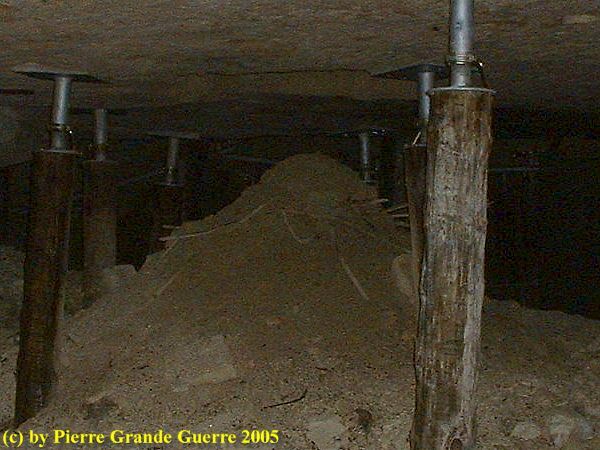
Just before we leave the Caverne du Dragon, we read this expressive graffiti of a French Soldier: "No more 16 April 1917" .
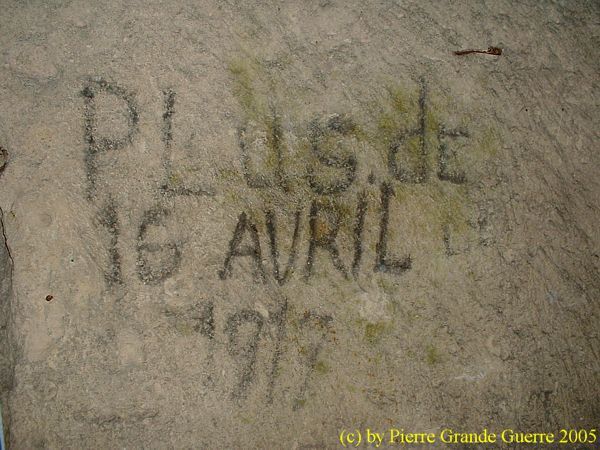
We leave the quarry to catch some fresh air to continue our trip along the Chemin des Dames.

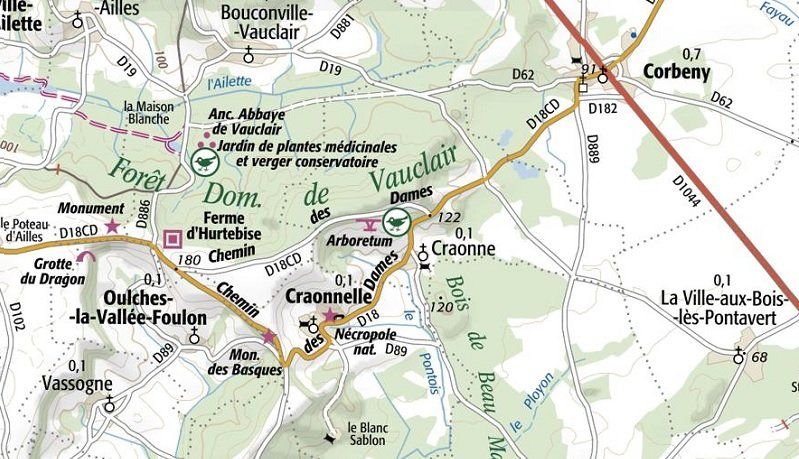
Out of the cave we continue eastward, passing the monument to commemorate...
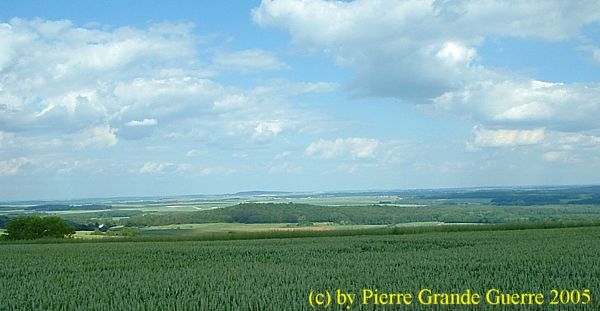
... the 36e Bataillon Basque , a batallion of soldiers from the Pyrenéees, fighting here.
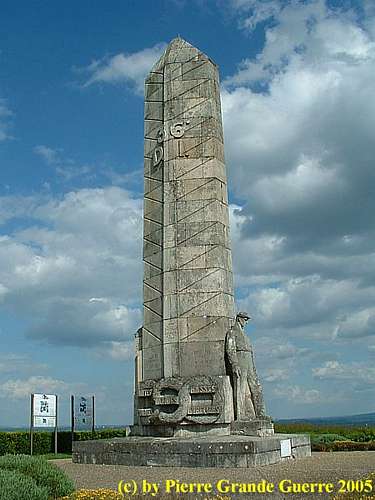
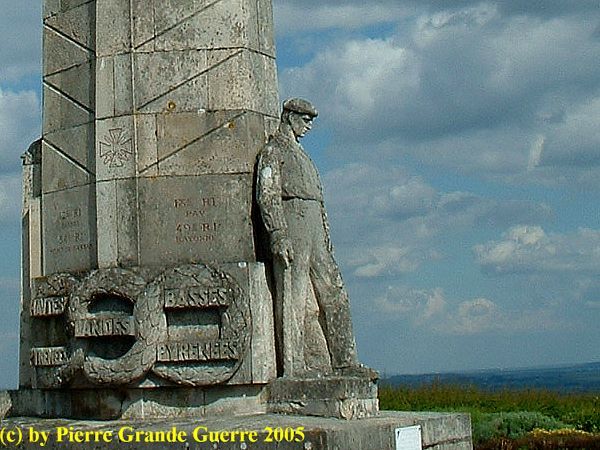
From the memorial a view over the Aisne valley.
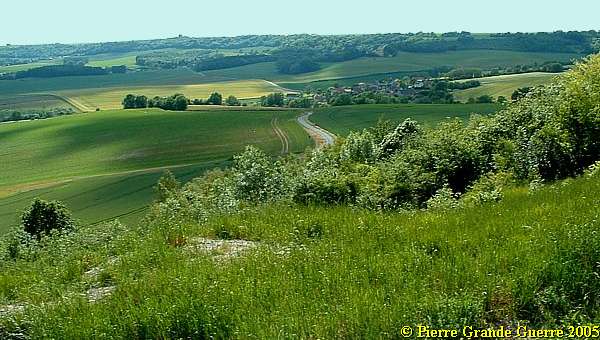
From here we turn the first road, the D 886, left to the ruins of the Vauclair Abby.
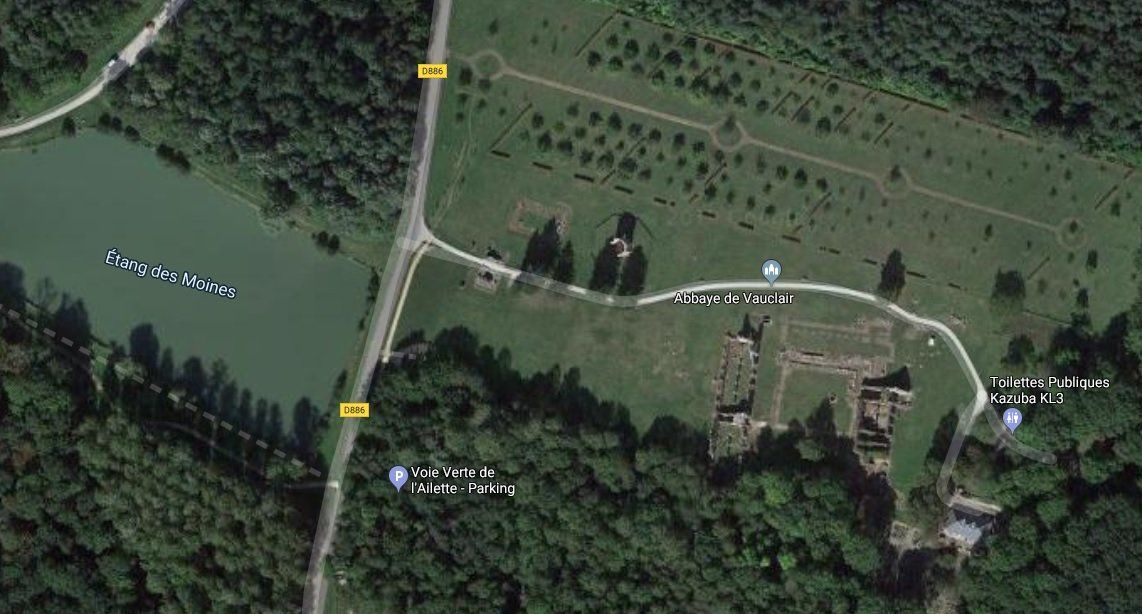
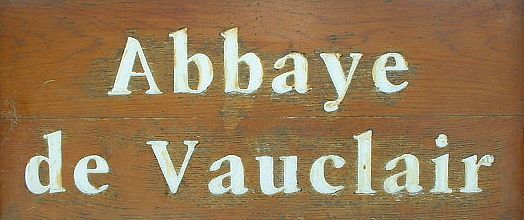
These are the ruins of an old Cistercienzer convent complex of the 12th century, founded by St. Bernhard.
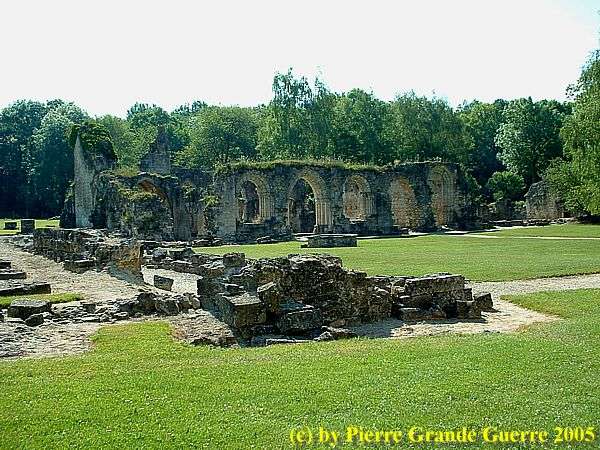
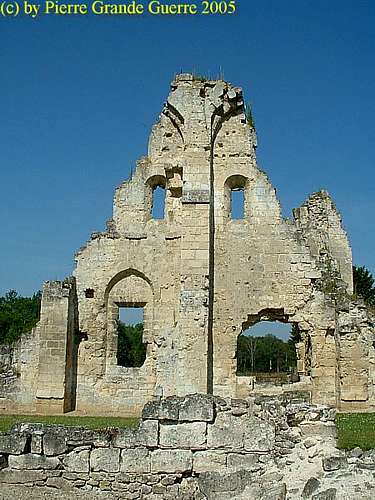
In 1915 the Germans partly destroyed the convent...
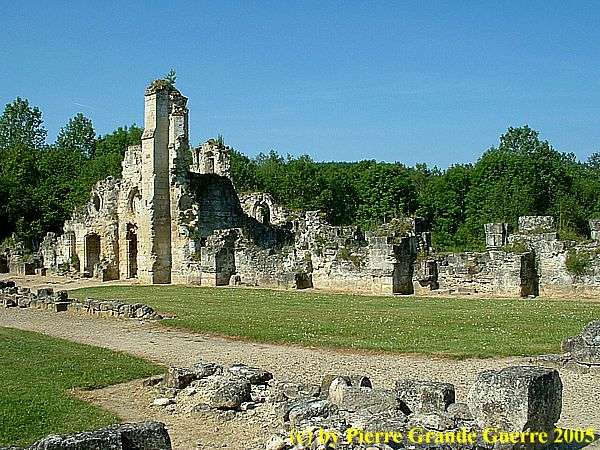
... to install an extensive observation post and a base for artillery- guns.
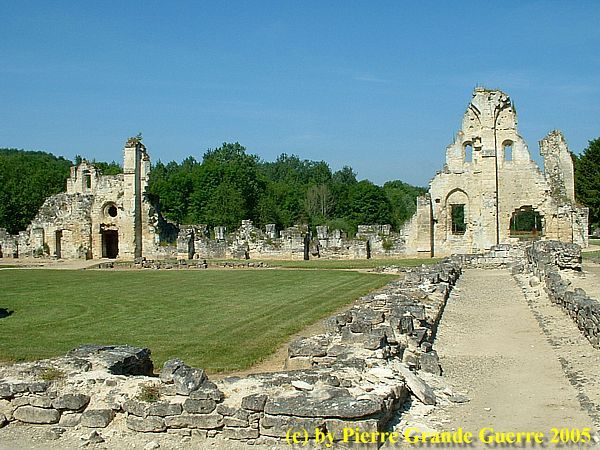
Of course this base attracted also French shell fire, ...
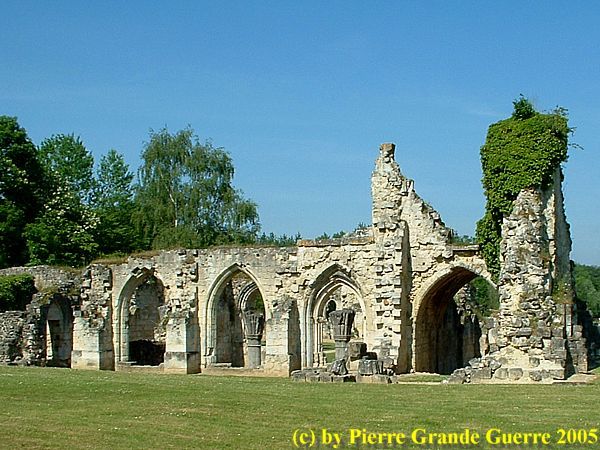
... which destroyed even more of what was left of the abby.
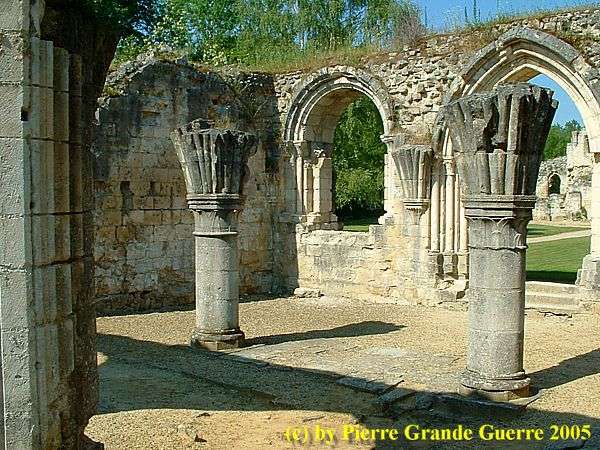
Around 1965 some archeology students tried to restore some of the relics.
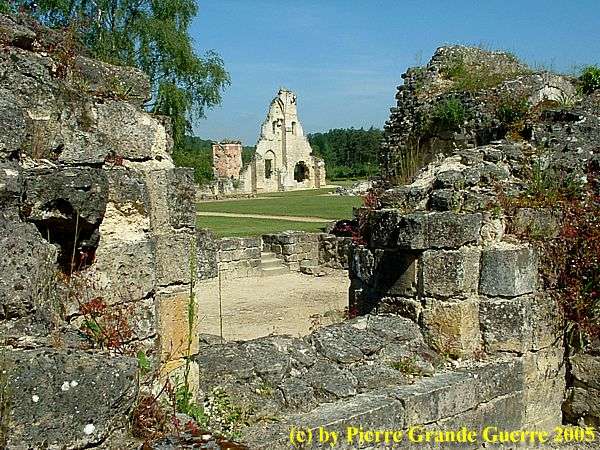
But still one can recognize bullet holes and shell impacts.
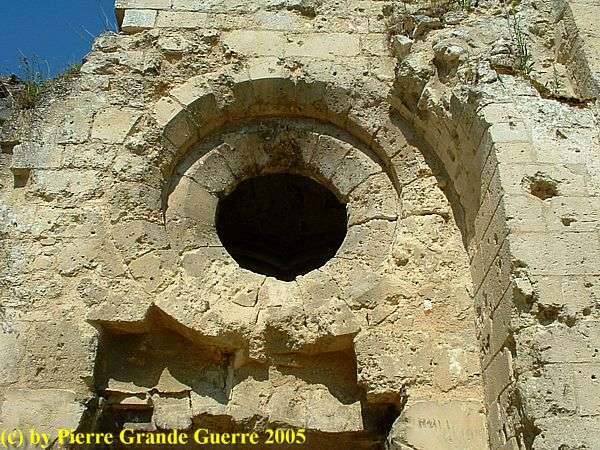
On first sight it looks like destruction by times gone by, ...
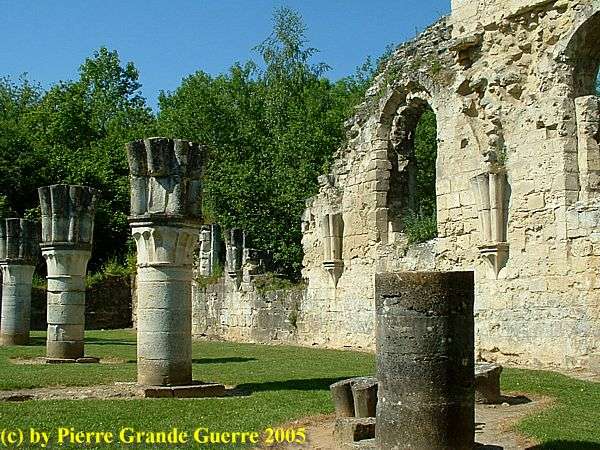
... but if you look with some more attention, you will notice everywhere traces of man-made destruction.
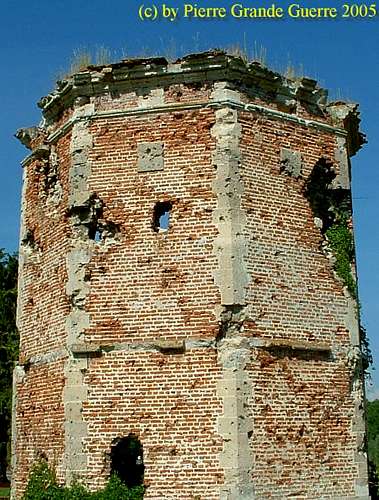
We return to the D 18DC to continue to the Plateau de Californie. A view over the battlefield of the Aisne valley from the Plateau de Californie.

I made this photo from the observation point. Left....
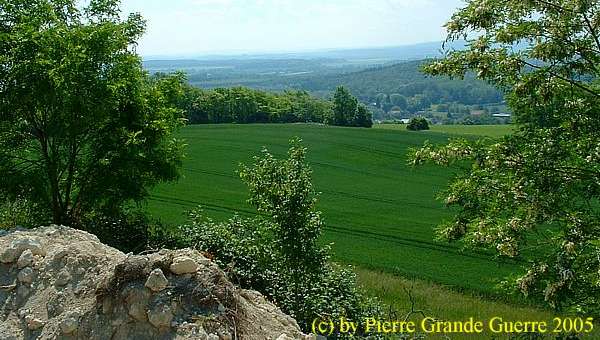
Right.
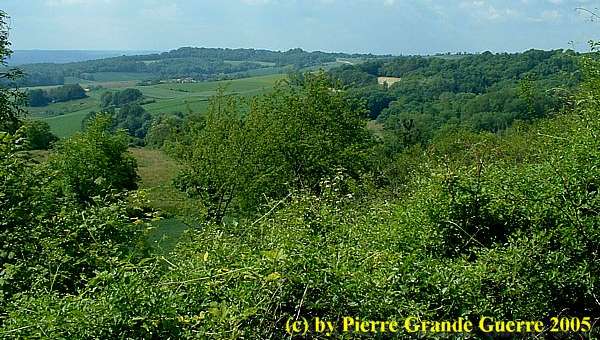
Above this panorama site used to stand this memorial, which nowadays is to be found in front of the Musée du Caverne du Dragon.
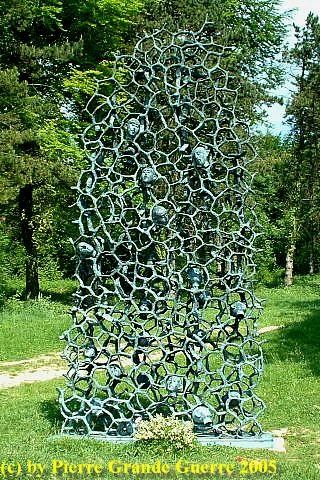
We continue to Craonnelle where we pass the Nécropole Nationale de Craonnelle .
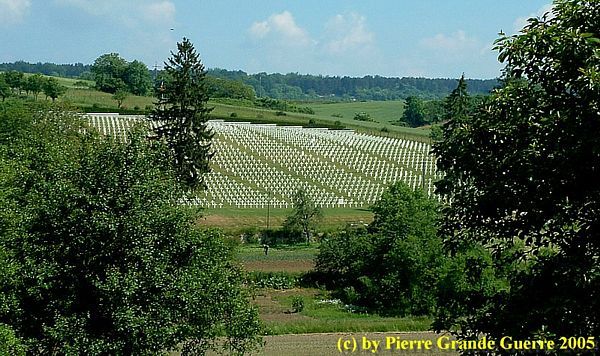
The
Nécropole Nationale de Craonnelle
lies on the edge of the D18 between Craonnelle and Craonne. Originally this cemetery was built during the war near a first aid dressing station.
The cemetery was created in 1920 and it contains 3,936 graves of combatants fallen at the Chemin des Dames from 1914 to 1918 in particular from the Plateau de Californie
, from the Craonnelle relief posts, Vassogne, Jumigny, Craonne, and the Moulin de Vauclair.
There are buried 3,910 French soldiers. 1,884 of them are buried in ossuaries. There are also 24 graves of British soldiers, mixed here and there with the French tombs, of which only 7 soldiers could be identified, as well as 2 Belgian soldiers.
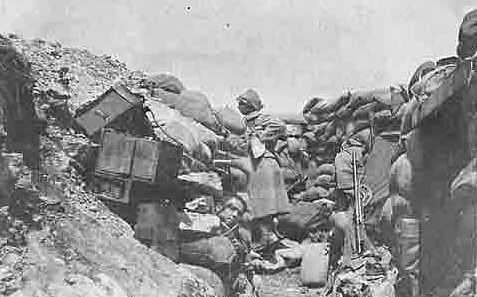
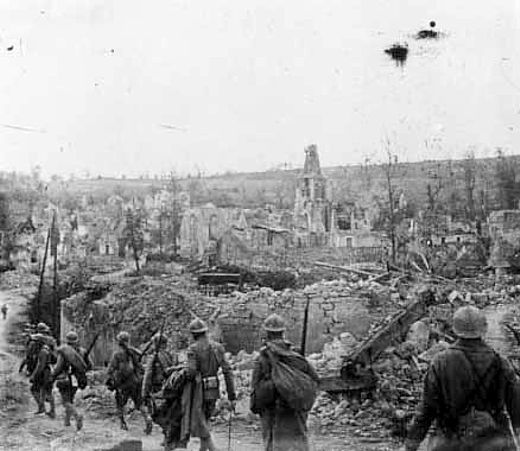
An entrance of a German pill box in the destroyed village of Craonne-le-Vieux.

In 2005 we ran out of time, so we had to finish south of the Chemin des Dames with a visit to the
Monument des Chars d'Assaut
, the Tank Monument, north of
Berry-au-Bac
.
We go south via the D 89 to Pontavert and from there westward on the D 925.
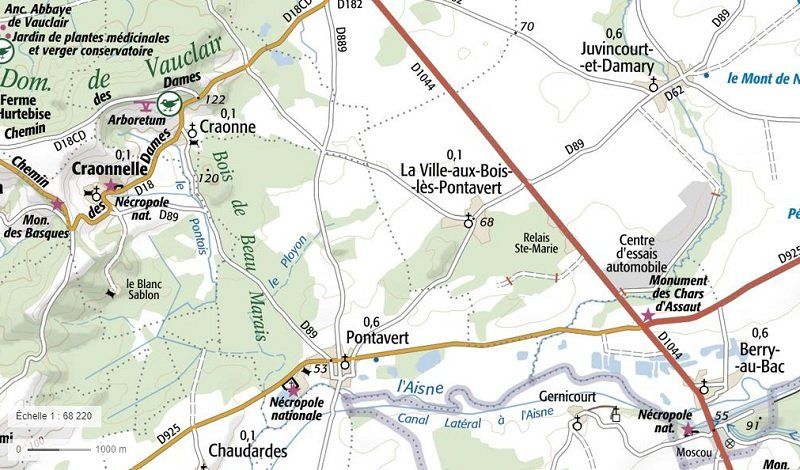
The Tank Monument stands on the site of La Ferme du Cholera, Cholera Farm, the location from where the French army deployed tanks during the Nivelle offensive.
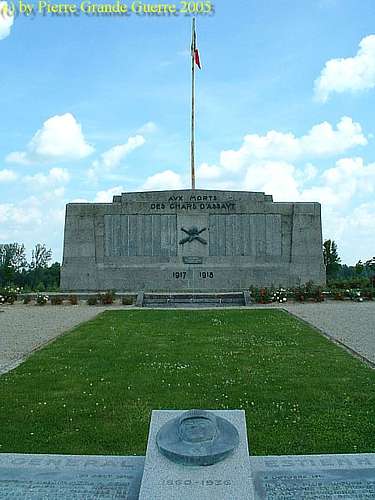
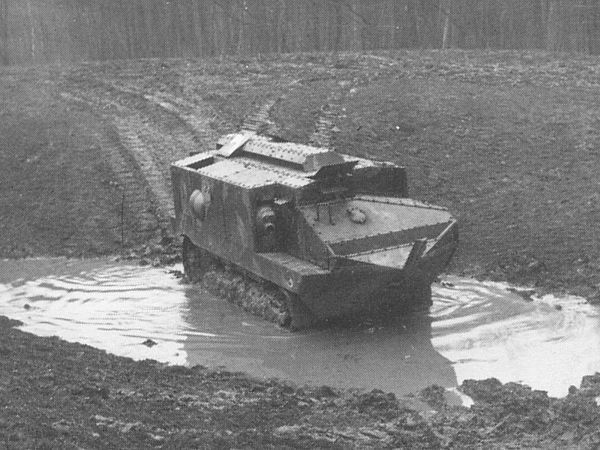
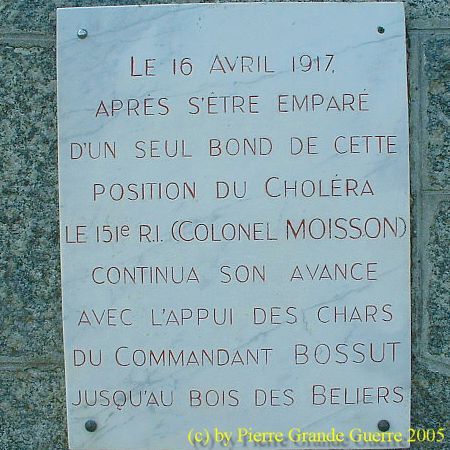
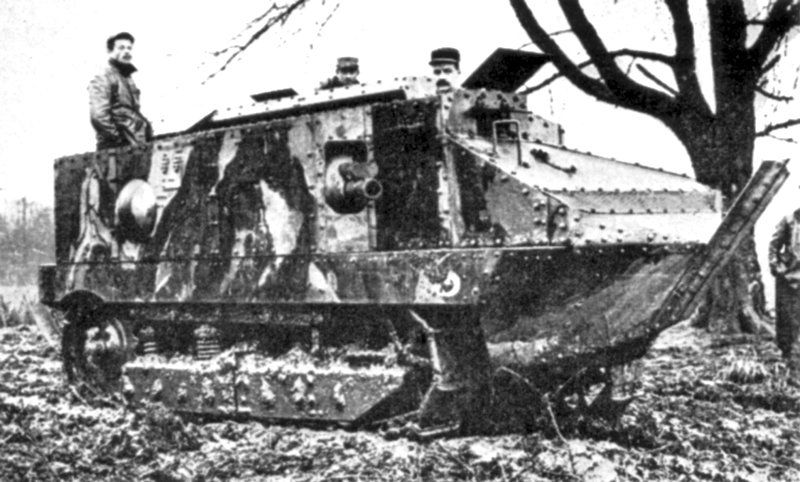
With this French Tank Memorial at Cholera Farm we arrive at the finish of this photo impression of the Chemin des Dames.
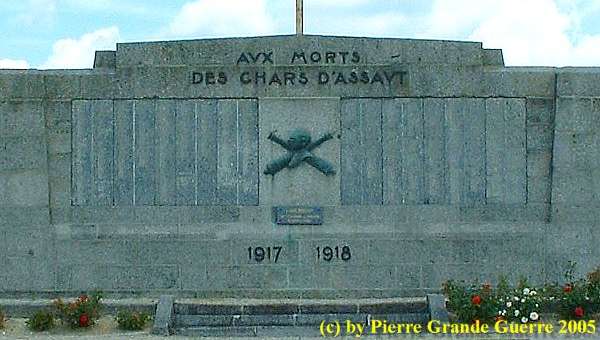
Continue to: " ALSACE-LORRAINE - The Gap of Charmes - La Trouée de Charmes "







